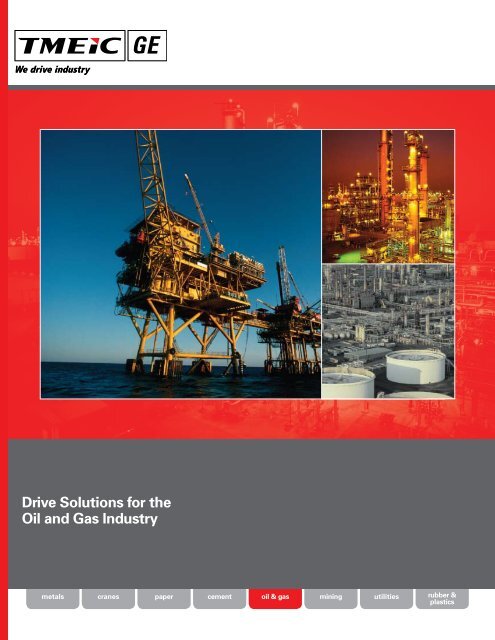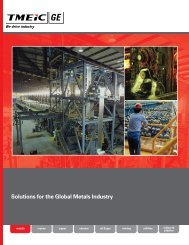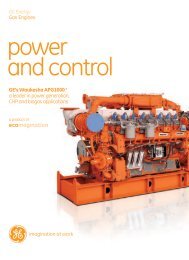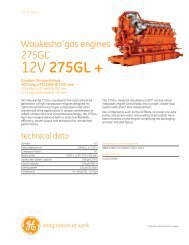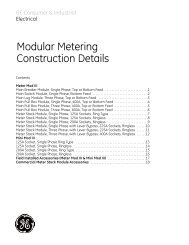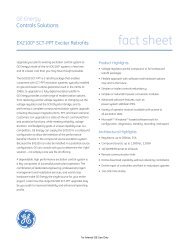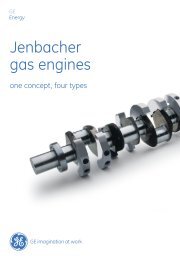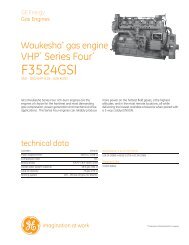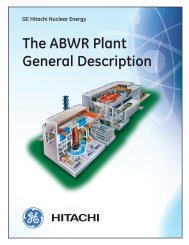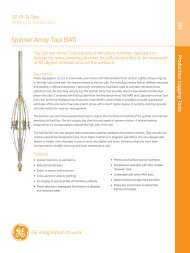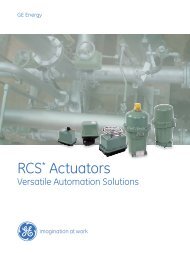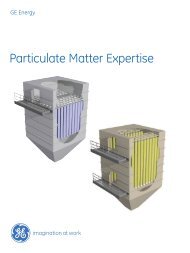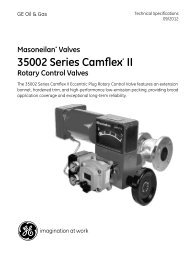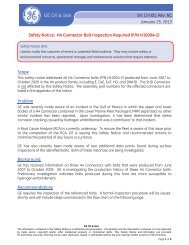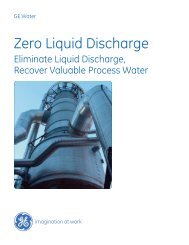Drive Solutions for the Global Oil and Gas Industry ... - GE Energy
Drive Solutions for the Global Oil and Gas Industry ... - GE Energy
Drive Solutions for the Global Oil and Gas Industry ... - GE Energy
Create successful ePaper yourself
Turn your PDF publications into a flip-book with our unique Google optimized e-Paper software.
<strong>Drive</strong> <strong>Solutions</strong> <strong>for</strong> <strong>the</strong><br />
<strong>Oil</strong> <strong>and</strong> <strong>Gas</strong> <strong>Industry</strong><br />
metals<br />
cranes<br />
paper<br />
cement<br />
oil & gas<br />
mining<br />
utilities<br />
rubber &<br />
plastics
About TMEIC <strong>GE</strong><br />
TMEIC <strong>GE</strong> is a joint venture between General<br />
Electric, Toshiba, <strong>and</strong> Mitsubishi Electric in <strong>the</strong><br />
industrial system drives business.<br />
The adjacent<br />
diagram shows how <strong>the</strong> companies came toge<strong>the</strong>r<br />
between 2000 <strong>and</strong> 2003 to create an organization of<br />
2,200 people with annual sales exceeding $2B.<br />
TMEIC <strong>GE</strong> is built upon <strong>the</strong> combined <strong>and</strong> proud<br />
heritage of <strong>the</strong>se great companies. We focus on <strong>the</strong><br />
customer, working to provide superior products <strong>and</strong><br />
excellent service, delivering customer success every<br />
project, every time.<br />
General<br />
Electric<br />
Toshiba<br />
Mitsubishi<br />
Electric<br />
TMEIC <strong>GE</strong> Automation Systems<br />
Adjustable Speed <strong>Drive</strong>s in <strong>the</strong> <strong>Oil</strong> & <strong>Gas</strong> <strong>Industry</strong><br />
Every step of <strong>the</strong> way, from <strong>the</strong> wellhead to <strong>the</strong> finished<br />
fuel products, large, adjustable-speed drives are use to<br />
start motors <strong>and</strong> control flow.<br />
In gas & oil pipelines, driving large pumps <strong>and</strong><br />
compressors, varying speed to control flow –<br />
see Application 3, page 10.<br />
In offshore plat<strong>for</strong>ms, driving gas<br />
compressors <strong>and</strong> oil pumps, moving<br />
fluids to onshore – see Application 2,<br />
page 8.<br />
In liquefied natural gas plants, driving<br />
large compressors <strong>and</strong> varying speed to<br />
control flow – see Application 4, page 12.<br />
In refineries, driving large compressors<br />
<strong>and</strong> varying speed to control flow – see<br />
Application 1, page 6.<br />
The compressors <strong>and</strong> pumps use drives to smoothly start<br />
<strong>the</strong> large motors <strong>and</strong> continuously adjust <strong>the</strong> speed to<br />
control flow. Controlling flow by adjusting speed avoids<br />
energy wasted in <strong>the</strong> throttling valves. When large flows<br />
are involved <strong>and</strong> <strong>the</strong> motor energy consumption is<br />
significant, varying <strong>the</strong> speed is <strong>the</strong> answer.<br />
With large machines, <strong>the</strong> electrical power savings amount<br />
to hundreds of thous<strong>and</strong>s of dollars per year. In addition,<br />
<strong>the</strong> motor is protected against starting inrush currents, <strong>and</strong><br />
control valve maintenance expenses <strong>and</strong> resulting<br />
downtime are minimized.<br />
Page 2 of 32<br />
© 2009 TMEIC <strong>GE</strong> Automation Systems. All Rights Reserved.<br />
Preliminary<br />
Revised: 5-22-09
Why Use Electrical Adjustable Speed <strong>Drive</strong>s?<br />
Here are some of <strong>the</strong> reasons to use electrical medium voltage drives:<br />
Increased Reliability – Pages 5, 6<br />
Variable speed motor-drive systems are more reliable than traditional approaches such as using<br />
turbines to control flow. They can also be configured in redundant channel configurations such as<br />
triple module redundancy (TMR) <strong>for</strong> very high reliability.<br />
Dramatic <strong>Energy</strong> Savings – Pages 5, 6, 10<br />
With a variable speed motor-drive system, <strong>the</strong> flow control valve is not required, avoiding large flow<br />
energy losses. In fact, <strong>the</strong> variable speed motor-drive system is more efficient than all o<strong>the</strong>r flow<br />
control methods including turbines <strong>and</strong> hydraulic transmissions. For more in<strong>for</strong>mation on this topic,<br />
refer to Selecting Variable Speed <strong>Drive</strong>s <strong>for</strong> Flow Control in <strong>the</strong> library at www.tmeicge.com.<br />
Significantly Less Maintenance – Pages 5, 6<br />
The oil & gas industry is all about system availability; variable speed motor-drive systems require<br />
virtually no maintenance. This is in sharp contrast to flow control valves, guide vanes, <strong>and</strong> turbines<br />
that do require extensive periodic maintenance <strong>and</strong> associated downtime.<br />
Air & Noise Pollution Virtually Eliminated – Pages 6, 12<br />
<strong>Gas</strong> turbines used to drive compressors can generate significant air <strong>and</strong> noise pollution. In populated<br />
areas, this can be a serious issue. Variable speed motor-drive systems generate no air pollution <strong>and</strong><br />
negligible noise.<br />
Soft Starting One or Multiple Motors, <strong>and</strong> Power Factor Correction – Pages 6, 9<br />
When electric drives start large motors, starting inrush current with associated mechanical <strong>and</strong><br />
<strong>the</strong>rmal wiring stress is eliminated. This removes limitations on motor frequency of starts, reduces<br />
insulation damage, <strong>and</strong> provides extended motor life. With synchronization logic, one drive can start<br />
multiple motors. Many large drive configurations also improve overall system power factor.<br />
Why TMEIC <strong>GE</strong> MV <strong>Drive</strong>s Make Sense<br />
Choose TMEIC <strong>GE</strong>, a <strong>Global</strong> Supplier – Page 20<br />
TMEIC <strong>GE</strong> sells <strong>and</strong> services drive systems round <strong>the</strong> world, supported by engineering <strong>and</strong> service<br />
offices <strong>and</strong> spare parts depots in North America, South America, Europe, Asia, <strong>and</strong> Australia.<br />
We’ve got you covered! A Complete Family of <strong>Drive</strong>s – Page 21<br />
Our family of medium voltage (MV) drives covers all your needs from 450 hp up to 120,000 hp (335<br />
kW to 90,000 kW); with a wide voltage range up to 7.2 kV to meet your requirements.<br />
Our Medium Voltage (MV) System Experts can Help You – Page 14<br />
TMEIC <strong>GE</strong> drive <strong>and</strong> motor application engineers bring an average of 20 years of practical industry<br />
experience to your application. After analyzing your MV system requirements, <strong>the</strong>y can recommend<br />
<strong>the</strong> most cost effective solution <strong>and</strong> design <strong>the</strong> system <strong>for</strong> you.<br />
Common Toolbox Software – Pages 17, 22, 24<br />
The <strong>GE</strong> Control System Toolbox is world-class configuration software. It is used on all <strong>the</strong> TMEIC<br />
<strong>GE</strong> drives <strong>and</strong> legacy <strong>GE</strong> drives, so once trained, your service engineers can work on any of our<br />
drives without going back to school.<br />
Revised: 5-22-09 © 2009 TMEIC <strong>GE</strong> Automation Systems. All Rights Reserved.<br />
Page 3 of 32<br />
Preliminary
Comparison of Electrical & Mechanical Flow Control Methods<br />
Flow Control Methods<br />
Power Train Train<br />
Electrical <strong>Drive</strong>s <strong>Drive</strong>s<br />
Electric<br />
Frequency<br />
Control<br />
Electric<br />
Frequency<br />
Control<br />
2,216 kW<br />
Three-<br />
Phase<br />
Electric<br />
Supply<br />
* Annual Electric<br />
Cost $1,358,709<br />
TMdrive-70<br />
Electric<br />
Adjustable<br />
Speed<br />
<strong>Drive</strong> (ASD)<br />
96.4%<br />
Redundant<br />
Elect. ASD<br />
Channel 1<br />
Channel 2<br />
Channel 3<br />
97.3%<br />
2,136 kW<br />
Electric Motor<br />
98%<br />
Variable speed<br />
Synchronous<br />
Electric Motor<br />
Variable speed<br />
2,094 kW<br />
1:1<br />
1:1<br />
85%<br />
1,780 kW<br />
<strong>Gas</strong> flow<br />
Variable speed compressor<br />
2,196 kW LCI 2,136 kW<br />
2,094 kW<br />
1,780 kW<br />
Three-<br />
Phase<br />
Electric<br />
Supply<br />
*<br />
Annual Electric<br />
Cost $1,346,604<br />
2,698 kW<br />
98% 85%<br />
2,644 kW<br />
<strong>Gas</strong> flow<br />
Variable speed compressor<br />
1,780 kW<br />
Mechanical Control Control<br />
Valve Control<br />
Hydraulic<br />
Variable Speed<br />
Control<br />
Steam or Fuel<br />
Control<br />
*<br />
*<br />
*<br />
Three-<br />
Phase<br />
Electric<br />
Supply<br />
Annual Electric<br />
Cost $1,654,388<br />
Three-<br />
Phase<br />
Electric<br />
Supply<br />
Annual Electric<br />
Cost $1,416,492<br />
Steam,<br />
<strong>Gas</strong>, or<br />
Kerosene<br />
Motor<br />
Starter<br />
Motor<br />
Starter<br />
Fuel or<br />
Steam<br />
Control<br />
2,310 kW<br />
Electric Motor<br />
98%<br />
Fixed speed<br />
Electric Motor<br />
98%<br />
Fixed speed<br />
Turbine<br />
37%<br />
Variable speed<br />
2,264 kW<br />
1:1<br />
1: N<br />
Hydraulic<br />
Var. Speed<br />
Control<br />
92.5%<br />
5,659 kW 2,094 kW<br />
Annual <strong>Gas</strong><br />
Cost $1,963,084<br />
1:1<br />
2,094 kW<br />
85%<br />
Valve<br />
Control<br />
Fixed speed compressor<br />
85%<br />
1,780 kW<br />
<strong>Gas</strong> flow<br />
Variable speed compressor<br />
85%<br />
1,780 kW<br />
<strong>Gas</strong> flow<br />
Variable speed compressor<br />
* Common conditions <strong>for</strong> above cases :<br />
- LCI drive is <strong>the</strong> basis <strong>for</strong> cost comparison - LCI has 97.3% efficiency<br />
- Nominal 4,000 hp compressor<br />
- Synchronous motor is used, efficiency 98% - Power cost $0.07/kWh.<br />
- Continuous operation at 85%<br />
(induction motor efficiency is 95%)<br />
- Natural gas cost, industrial rate,<br />
rated speed or equivalent flow<br />
- <strong>Gas</strong> turbine has 37% <strong>the</strong>rmal efficiency<br />
Dec. 2005, is $12.00/1,000 cu ft<br />
Page 4 of 32<br />
© 2009 TMEIC <strong>GE</strong> Automation Systems. All Rights Reserved.<br />
Preliminary<br />
Revised: 5-22-09
Save <strong>Energy</strong>, Increase Reliability, Control Motor Current, Reduce Pollution, Reduce Noise<br />
Strengths/Limitations Availability <strong>Energy</strong> Cost<br />
+ Very high efficiency<br />
+ ASD has high reliability<br />
+ Protects <strong>the</strong> motor against<br />
starting inrush currents<br />
+ Can have alternate assignments<br />
- May require an air conditioned<br />
area or equipment house<br />
- May require an increaser gearbox<br />
+ Very high efficiency<br />
+ Redundant ASD has very high<br />
reliability<br />
+ Protects <strong>the</strong> motor against<br />
starting inrush currents<br />
+ Can have alternate assignments<br />
- May require an air conditioned<br />
area or equipment house<br />
- May require an increaser gearbox<br />
Availability<br />
1.0000<br />
0.999992<br />
0.9990<br />
Availability<br />
1.0000<br />
0.999994<br />
0.9990<br />
Advanced Pulse Width<br />
Modulated drive TMdrive-70<br />
Adjustable Speed <strong>Drive</strong><br />
The only online<br />
maintenance required is<br />
changing <strong>the</strong> filters<br />
MTBF is 127,000 hours<br />
Repair time (MTTR) is 1.0<br />
hour; spares are required<br />
Individual LCI channels can<br />
be isolated <strong>and</strong> repaired at<br />
any time while <strong>the</strong> o<strong>the</strong>r 2<br />
channels continue to drive<br />
<strong>the</strong> motor<br />
MTBF is 175,000 hours<br />
Repair time (MTTR) is 1.1<br />
hours; spares are required<br />
<br />
*<br />
TMdrive-70 ASD flow control<br />
system uses $1,358,709 of<br />
electrical energy per year.<br />
*<br />
LCI ASD flow control system<br />
uses $1,346,604 of electrical<br />
energy per year, <strong>the</strong> basis <strong>for</strong><br />
cost comparison.<br />
+ Valve is very reliable<br />
+ Valve is fast acting <strong>for</strong> good flow<br />
control<br />
+ Valve is compact<br />
- Large energy loss in <strong>the</strong> throttling<br />
valve<br />
- Valve requires frequent<br />
maintenance<br />
- May require an increaser gearbox<br />
+ Can adjust speed well above <strong>and</strong><br />
below <strong>the</strong> motor speed<br />
+ Hydraulic transmission is reliable<br />
- Very low efficiency at lower speeds<br />
- Dedicated to motor; no redundancy<br />
- Repair is a lengthy procedure<br />
+ Can run at high speeds so gearbox<br />
is not required<br />
- <strong>Gas</strong> turbine requires frequent<br />
maintenance<br />
- Dedicated to motor, no redundancy<br />
- <strong>Gas</strong> turbine can produce air<br />
pollution <strong>and</strong> noise<br />
Note : Efficiency of mechanical devices decreases at<br />
lower speeds, but electric drive efficiency is constant<br />
over <strong>the</strong> operating range, so savings using ASD<br />
increase as speeds are lowered; see page 31.<br />
Availability<br />
1.0000<br />
0.99963<br />
0.9990<br />
Availability<br />
1.0000<br />
0.99923<br />
0.9990<br />
Availability<br />
1.0000<br />
0.9990<br />
0.9990<br />
Routine maintenance such<br />
as tightening packing can be<br />
done on line<br />
Control valve is down <strong>for</strong><br />
between 1 to 7 days if it fails<br />
<strong>and</strong> <strong>the</strong>re is no spare<br />
estimate MTTR is 96 hours<br />
MTBF approx 260,000 hours<br />
Spare valve required<br />
Maintenance intervals up to<br />
80,000 hours<br />
Hydraulic transmission is<br />
down <strong>for</strong> as much as 84<br />
hours (3 1/2 days) if a failure<br />
occurs (published literature)<br />
MTBF is 110,000 hours<br />
<strong>Gas</strong> turbine requires a<br />
month downtime every 3<br />
years; MTBF is 8,000 hours.<br />
Liquid fuel turbine requires 8<br />
hours downtime every year<br />
Steam turbine is taken down<br />
every 4 years<br />
Assume MTTR is 8 hours<br />
Mean Time To Repair (MTTR) <strong>and</strong><br />
Mean Time Between Failures (MTBF) are<br />
based on plant operating experience.<br />
* Valve flow control system<br />
uses $1,654,388 of electrical<br />
energy per year.<br />
This is $308,000 more than<br />
<strong>the</strong> electric adjustable speed<br />
drive.<br />
* Hydraulic gearbox flow<br />
control uses $1,416,492 of<br />
electrical energy per year.<br />
This is $70,000 more than <strong>the</strong><br />
electric adjustable speed<br />
drive.<br />
* <strong>Gas</strong> turbine flow control uses<br />
$1,963,084 of gas energy per<br />
year.<br />
This is $616,000 more than<br />
<strong>the</strong> electric adjustable speed<br />
drive.<br />
Availability =<br />
MTBF<br />
MTBF+ MTTR<br />
Revised: 5-22-09 © 2009 TMEIC <strong>GE</strong> Automation Systems. All Rights Reserved.<br />
Page 5 of 32<br />
Preliminary
<strong>Drive</strong> Applications <strong>for</strong> Compressors & Pumps<br />
Adjustable speed drives are often used to control <strong>the</strong> speed of compressors <strong>and</strong> pumps in <strong>the</strong> oil <strong>and</strong> gas industry. Most of<br />
<strong>the</strong> ASD applications control flow through pipelines <strong>and</strong> control <strong>the</strong> input flow to large process units. The following seven<br />
pages describe five typical applications <strong>and</strong> present <strong>the</strong> reasons why an electrical solution was chosen.<br />
1. Refinery compressors 4. Gearless high-speed compressor drive<br />
2. Offshore plat<strong>for</strong>m pumps 5. Liquid natural gas plant compressors<br />
3. <strong>Gas</strong> pipeline compressors<br />
Application 1. Refinery 1. Refinery Compressors<br />
Compressors<br />
A large refinery used gas turbines to drive two compressors. The turbines generated nitrogen oxides (NOX), noise pollution,<br />
<strong>and</strong> required more maintenance than electric motor drives. The refinery looked at using electric motors <strong>and</strong> hydraulic<br />
variable speed gearboxes, compared this with electric drives, <strong>and</strong> chose an electric drive as <strong>the</strong> best solution.<br />
The refinery’s new approach was to:<br />
• Replace <strong>the</strong> two gas turbines with two electric<br />
motors of 30,000 hp, <strong>and</strong> use one LCI adjustable<br />
speed drive <strong>for</strong> motor starting <strong>and</strong> speed control.<br />
• Use gear boxes to increase <strong>the</strong> speed input to <strong>the</strong><br />
compressors from <strong>the</strong> 1,800 rpm motor speed.<br />
• Use <strong>the</strong> adjustable speed drive to start one motor<br />
<strong>and</strong> synchronize it with <strong>the</strong> 13.8 kV bus.<br />
• Employ switchgear to put this motor across <strong>the</strong><br />
line <strong>and</strong> run <strong>the</strong> compressor at constant speed.<br />
• Use <strong>the</strong> adjustable speed drive to start <strong>the</strong> second<br />
motor <strong>and</strong> continuously vary <strong>the</strong> speed of <strong>the</strong><br />
second compressor to obtain <strong>the</strong> flow required by<br />
<strong>the</strong> process.<br />
Advantages of <strong>the</strong> <strong>Drive</strong> System<br />
Very high reliability – The LCI has built in channel <strong>and</strong> component redundancy allowing operation with<br />
a single failure without any reduction in power output. Consisting of three parallel active channels, <strong>the</strong><br />
LCI can operate on two channels while <strong>the</strong> third is being repaired. This is a TMR system with no voting.<br />
See next page.<br />
Eliminate air & noise pollution – <strong>Gas</strong> turbine exhaust NOX <strong>and</strong> noise are avoided completely,<br />
producing an environmentally friendly installation.<br />
The electrical drive system, <strong>the</strong>re<strong>for</strong>e, does not<br />
present problems meeting federal <strong>and</strong> state air <strong>and</strong> noise pollution limits.<br />
<strong>Energy</strong> savings – The LCI provides higher energy efficiency than ei<strong>the</strong>r gas turbines or hydraulic<br />
variable speed drives. In addition, <strong>the</strong> synchronous motors have 17% higher efficiency than <strong>the</strong> turbines<br />
<strong>the</strong>y replace.<br />
Increased run time compared to turbine – Electric drives <strong>and</strong> AC motors require much less<br />
maintenance <strong>and</strong> down time than gas turbines. <strong>Drive</strong> availability is <strong>the</strong> highest of all adjustable speed<br />
choices; <strong>for</strong> this application 0.999994.<br />
Page 6 of 32<br />
© 2009 TMEIC <strong>GE</strong> Automation Preliminary Systems. All Rights Reserved.<br />
Revised: 5-22-09
Adjustable Speed <strong>Drive</strong> System One-Line Diagram<br />
The TMEIC <strong>GE</strong> LCI (Load Commutated Inverter) was selected <strong>for</strong> this drive application. It is a medium voltage drive <strong>and</strong><br />
operates at 4.16 kV. Trans<strong>for</strong>mers drop <strong>the</strong> voltage from 13.8 kV, <strong>and</strong> after <strong>the</strong> drive, trans<strong>for</strong>mers increase <strong>the</strong> voltage to<br />
13.8 kV to supply <strong>the</strong> motors. The drive has two levels of redundancy as shown in <strong>the</strong> diagram.<br />
138 kV bus<br />
138 kV bus<br />
Two Levels of Redundancy<br />
60/65 MVA<br />
138/13.8 kV<br />
OA/FA<br />
13.8 kV bus NO<br />
18-pulse<br />
LCI drive<br />
system<br />
60/65 MVA<br />
138/13.8 kV<br />
OA/FA<br />
Device Level Redundancy. Each set of six<br />
silicon controlled rectifiers (SCR) in <strong>the</strong> power<br />
bridge includes an extra SCR to create N+1<br />
redundancy. If one SCR fails, <strong>the</strong> o<strong>the</strong>r five can<br />
operate at full power. This raises <strong>the</strong> reliability<br />
of each channel <strong>and</strong> also reduces <strong>the</strong> stress<br />
on <strong>the</strong> individual SCRs, providing longer life.<br />
15 MVA<br />
13.8/4.16 kV<br />
One channel power bridge showing<br />
thyristor (SCR) stacks <strong>and</strong> water cooling.<br />
15 MVA<br />
4.16/13.8 kV<br />
Exciters<br />
Channel Level Redundancy. The LCI has<br />
three 15,000 hp channels, <strong>and</strong> has <strong>the</strong><br />
capability of driving ei<strong>the</strong>r of <strong>the</strong> motors. If<br />
maintenance is being per<strong>for</strong>med on one<br />
channel, <strong>the</strong> o<strong>the</strong>r two channels can continue<br />
to power <strong>the</strong> motor. The out-of-service channel<br />
can <strong>the</strong>n be isolated, repaired, <strong>and</strong> returned to<br />
service. As a result, <strong>the</strong> drive reliability is<br />
extremely high <strong>and</strong> <strong>the</strong> equipment up time<br />
much higher than any o<strong>the</strong>r systems.<br />
30,000 HP, 1,800 RPM<br />
Synchronous Motor<br />
M<br />
30,000 HP, 1,800 RPM<br />
Synchronous Motor<br />
Gear boxes &<br />
compressors<br />
M<br />
Power Circuits. The LCI is an 18-pulse drive<br />
system using thryristors (SCRs) in <strong>the</strong><br />
converters <strong>and</strong> inverters. The system<br />
generates only a small harmonic disturbance<br />
to <strong>the</strong> power system.<br />
The two levels of redundancy illustrated above provide a 20-year system Mean Time Between Failures (MTBF) <strong>and</strong> excellent<br />
up-time with availability of 0.999994.<br />
Revised: 5-22-09 © 2009 TMEIC <strong>GE</strong> Automation Systems. All Rights Reserved.<br />
Page 7 of 32<br />
Preliminary
Application 2. Offshore Plat<strong>for</strong>m Pumps<br />
Application 2. Offshore 2. Offshore Plat<strong>for</strong>m Offshore<br />
Plat<strong>for</strong>m Pumps Plat<strong>for</strong>m<br />
Pumps<br />
Pumps<br />
Five production pumps on this offshore plat<strong>for</strong>m feed oil into a pipeline taking <strong>the</strong> product to onshore facilities. Three of <strong>the</strong><br />
2,250 hp pumps were under control of adjustable speed drives to adjust <strong>the</strong> total flow to dem<strong>and</strong>, <strong>and</strong> <strong>the</strong> o<strong>the</strong>r two were on<br />
fixed Five production speed. The pumps original on drives this offshore were obsolete plat<strong>for</strong>m <strong>and</strong> feed spare oil into parts a pipeline were difficult taking to <strong>the</strong> obtain. product In to addition, onshore <strong>the</strong> facilities. older drives Three required of <strong>the</strong><br />
power 2,250 hp factor pumps correction were under <strong>and</strong> power control line of filters adjustable to keep speed <strong>the</strong> power drives clean. to adjust These <strong>the</strong> total filters flow were to dem<strong>and</strong>, very noisy <strong>and</strong> <strong>for</strong> <strong>the</strong> employees o<strong>the</strong>r two working were on in<br />
<strong>the</strong> fixed equipment speed. The room original <strong>for</strong> long drives periods. were obsolete <strong>and</strong> spare parts were difficult to obtain. In addition, <strong>the</strong> older drives required<br />
power factor correction <strong>and</strong> power line filters to keep <strong>the</strong> power clean. These filters were very noisy <strong>for</strong> employees working in<br />
<strong>the</strong> equipment room <strong>for</strong> long periods.<br />
The oil production company wanted to:<br />
The • oil production Replace <strong>the</strong> company old drives wanted with new to: maintainable drives.<br />
Obtain high drive reliability backed by a five-year warranty.<br />
• Replace<br />
Obtain better<br />
<strong>the</strong> old<br />
system<br />
drives<br />
power<br />
with new<br />
factor<br />
maintainable<br />
without <strong>the</strong><br />
drives.<br />
use of correction.<br />
• Obtain<br />
Eliminate<br />
high<br />
<strong>the</strong><br />
drive<br />
noisy<br />
reliability<br />
power<br />
backed<br />
line filters<br />
by a five-year<br />
by using<br />
warranty.<br />
drives with<br />
• Obtain inherent better low harmonic system power distortion. factor without <strong>the</strong> use of correction.<br />
• Eliminate Have <strong>the</strong> ability <strong>the</strong> noisy to per<strong>for</strong>m power synchronous line filters bypass.<br />
using drives with<br />
inherent<br />
Reduce <strong>the</strong><br />
low<br />
component<br />
harmonic distortion.<br />
count to increase reliability <strong>and</strong> reduce<br />
• Have maintenance. <strong>the</strong> ability to per<strong>for</strong>m synchronous bypass.<br />
• Reduce <strong>the</strong> component count to increase reliability <strong>and</strong> reduce<br />
In making maintenance. its selection <strong>for</strong> <strong>the</strong> new drives, <strong>the</strong> company regarded<br />
experienced, local service support from <strong>the</strong> New Orleans office as<br />
In important. making its Throughout selection <strong>the</strong> <strong>for</strong> process, <strong>the</strong> new strong drives, application <strong>the</strong> company support regarded from<br />
experienced, <strong>the</strong> TMEIC <strong>GE</strong> local engineering service support office in from Virginia <strong>the</strong> proved New Orleans valuable. office as<br />
important. Throughout <strong>the</strong> process, strong application support from<br />
<strong>the</strong> TMEIC <strong>GE</strong> engineering office in Virginia proved valuable.<br />
The first of <strong>the</strong> three old drives was replaced with a Dura-Bilt5i MV. After evaluation, a second Dura-Bilt was installed on <strong>the</strong><br />
second pump. Each drive is equipped with <strong>the</strong> components <strong>for</strong> synchronous bypass in <strong>the</strong> future, although <strong>the</strong> actual bypass<br />
The contactors first of were <strong>the</strong> three not old initially drives included. was replaced A power with study a Dura-Bilt5i per<strong>for</strong>med MV. by After TMEIC evaluation, <strong>GE</strong> showed a second that <strong>the</strong> Dura-Bilt remaining was installed old drive on could <strong>the</strong><br />
second operate pump. without Each any filters drive since is equipped it represents with <strong>the</strong> a small components portion <strong>for</strong> of <strong>the</strong> synchronous load <strong>the</strong> bypass plat<strong>for</strong>m. in <strong>the</strong> future, although <strong>the</strong> actual bypass<br />
contactors were not initially included. A power study per<strong>for</strong>med by TMEIC <strong>GE</strong> showed that <strong>the</strong> remaining old drive could<br />
operate without any filters since it represents a small portion of <strong>the</strong> load on <strong>the</strong> plat<strong>for</strong>m.<br />
Benefits of <strong>the</strong> Dura-Bilt5i MV Pump System<br />
Benefits of <strong>the</strong> Dura-Bilt5i MV Pump System<br />
High Reliability. Advanced design including use of medium voltage Insulated Gate Bipolar Transistors<br />
(IGBTs), oil-filled capacitors, a built-in copper wound trans<strong>for</strong>mer, <strong>and</strong> surge <strong>and</strong> transient protection<br />
creates High Reliability. a drive with Advanced high reliability. design including use of medium voltage Insulated Gate Bipolar Transistors<br />
(IGBTs), oil-filled capacitors, a built-in copper wound trans<strong>for</strong>mer, <strong>and</strong> surge <strong>and</strong> transient protection<br />
creates a drive with high reliability.<br />
Low Harmonic Distortion. The 24-pulse rectifier’s low harmonic impact of less than 1.5% distortion<br />
gives clean operation without <strong>the</strong> use of filters, allowing <strong>the</strong> original filters to be disconnected.<br />
Low Harmonic Distortion. The 24-pulse rectifier’s low harmonic impact of less than 1.5% distortion<br />
gives clean operation without <strong>the</strong> use of filters, allowing <strong>the</strong> original filters to be disconnected.<br />
High Power Factor. The new system has a very good power factor of better than 0.95 <strong>and</strong> does not<br />
require any external power factor correction equipment.<br />
High Power Factor. The new system has a very good power factor of better than 0.95 <strong>and</strong> does not<br />
require any external power factor correction equipment.<br />
Compact <strong>Drive</strong>. The Dura-Bilt drive system fits in a smaller space than <strong>the</strong> original system because<br />
<strong>the</strong> trans<strong>for</strong>mer is integrated into <strong>the</strong> cabinet <strong>and</strong> <strong>the</strong> heat pipe cooling allows a very compact drive.<br />
Compact <strong>Drive</strong>. The Dura-Bilt drive system fits in a smaller space than <strong>the</strong> original system because<br />
<strong>the</strong> trans<strong>for</strong>mer is integrated into <strong>the</strong> cabinet <strong>and</strong> <strong>the</strong> heat pipe cooling allows a very compact drive.<br />
Page 8 of 32<br />
© 2009 TMEIC <strong>GE</strong> Automation Preliminary Systems. All Rights Reserved.<br />
Preliminary<br />
Revised: 5-22-09
Pump System One-Line Diagram<br />
Plat<strong>for</strong>m MV Bus<br />
In this diagram, <strong>Drive</strong> 1 is shown<br />
with a synchronous bypass<br />
option, which can be added in <strong>the</strong><br />
future. This option will allow <strong>the</strong><br />
drive to:<br />
DB5i MV<br />
<strong>Drive</strong> 1<br />
Motor 1<br />
DB5i MV<br />
<strong>Drive</strong> 2<br />
Motor 2<br />
Older<br />
<strong>Drive</strong><br />
Motor 3<br />
Motor 4<br />
Motor 5<br />
• Start Motor 1 with low<br />
current inrush.<br />
• Bring <strong>the</strong> motor up to<br />
synchronous speed.<br />
• Synchronize <strong>the</strong> motor with<br />
<strong>the</strong> supply bus.<br />
• Put <strong>the</strong> motor across <strong>the</strong><br />
line <strong>and</strong> disconnect <strong>the</strong><br />
drive from <strong>the</strong> supply.<br />
• Allow <strong>Drive</strong> 2 to control<br />
Pump 2 flow as required<br />
by <strong>the</strong> flow dem<strong>and</strong>.<br />
This configuration allows Motor 1<br />
to run at full speed without <strong>the</strong><br />
heat losses in <strong>the</strong> drive. The<br />
synchronous option can be<br />
extended to <strong>the</strong> second drive if<br />
required.<br />
Pump 1<br />
Pump 2 Pump 3 Pump 4 Pump 5<br />
Future Improvements<br />
The customer has <strong>the</strong> option in <strong>the</strong> future to retire <strong>the</strong> last old drive <strong>and</strong><br />
install contactors on all motors <strong>and</strong> <strong>the</strong> two drives. With appropriate<br />
PLC control logic, <strong>the</strong> system will allow ei<strong>the</strong>r Dura-Bilt to start <strong>and</strong> run<br />
any of <strong>the</strong> five motors, <strong>and</strong> put <strong>the</strong>m across <strong>the</strong> line.<br />
This future system improvement will provide:<br />
• The maximum flexibility to operate <strong>the</strong> pumps under a wide<br />
range of situations.<br />
• Soft starting available <strong>for</strong> all motors to minimize system impact<br />
<strong>and</strong> deterioration of <strong>the</strong> windings caused by inrush current.<br />
• Reduction in <strong>the</strong> impact of drive downtime since no motor is<br />
dedicated to any drive.<br />
Revised: 5-22-09 © 2009 TMEIC <strong>GE</strong> Automation Systems. All Rights Reserved.<br />
Page 9 of 32<br />
Preliminary
Application 3. <strong>Gas</strong> Pipeline Compressors<br />
Application 3. <strong>Gas</strong> 3. <strong>Gas</strong> Pipeline Pipeline Compressors<br />
Compressors<br />
The remote gas pipeline station used two compressors in series, driven by internal combustion engines. With this<br />
The arrangement, remote gas non-optimal pipeline flow station often used wasted two energy, compressors <strong>and</strong> fixed in pumping series, steps driven provided by internal poor combustion pipeline flow engines. control.<br />
With this<br />
arrangement, non-optimal flow often wasted energy, <strong>and</strong> fixed pumping steps provided poor pipeline flow control.<br />
The pipeline company sought a new motor <strong>and</strong><br />
flow The control pipeline system company which sought would:<br />
a new motor <strong>and</strong><br />
flow control system which would:<br />
• Be responsive to fast changes in load.<br />
•<br />
Reduce Be responsive<br />
energy to<br />
usage.<br />
fast changes in load.<br />
•<br />
Increase Reduce energy<br />
reliability.<br />
usage.<br />
•<br />
Reduce Increase<br />
maintenance reliability.<br />
costs.<br />
• Reduce<br />
<strong>the</strong> maintenance<br />
heat load costs.<br />
in <strong>the</strong> building.<br />
•<br />
Keep Reduce<br />
<strong>the</strong> <strong>the</strong><br />
existing heat load<br />
induction in <strong>the</strong><br />
motors building.<br />
<strong>and</strong> speed<br />
• increasing Keep <strong>the</strong> existing gearboxes.<br />
induction motors <strong>and</strong> speed<br />
• Produce increasing<br />
clean gearboxes.<br />
electrical power with low<br />
• harmonics.<br />
Produce clean electrical power with low<br />
harmonics.<br />
After reviewing alternatives, <strong>the</strong> company decided<br />
to After replace reviewing <strong>the</strong> alternatives, two existing <strong>the</strong> internal company combustion<br />
decided<br />
engines to replace with <strong>the</strong> two medium existing internal voltage combustion adjustable<br />
speed engines drives with <strong>and</strong> two motors medium to match voltage <strong>the</strong> adjustable pressure<br />
<strong>and</strong> speed flow drives needs <strong>and</strong> of <strong>the</strong> motors pipeline.<br />
to match <strong>the</strong> pressure<br />
<strong>and</strong> flow needs of <strong>the</strong> pipeline.<br />
Induction Motor <strong>and</strong> Gearbox<br />
(compressor Induction located Motor on <strong>the</strong> <strong>and</strong> o<strong>the</strong>r Gearbox side of wall).<br />
(compressor located on <strong>the</strong> o<strong>the</strong>r side of wall).<br />
The new system uses two Dura-Bilt5i MV drives connected to<br />
induction The new motors. system uses These two motors Dura-Bilt5i drive <strong>the</strong> MV compressors drives connected through<br />
to<br />
gear induction boxes. motors. To house These <strong>the</strong> motors drives, a drive completely <strong>the</strong> compressors preassembled, through airconditioned<br />
gear boxes. power To house <strong>the</strong> was drives, selected.<br />
a completely preassembled, airconditioned<br />
power house was selected.<br />
Benefits of <strong>the</strong> Dura-Bilt5i MV Compressor <strong>Drive</strong> System<br />
Benefits of <strong>the</strong> Dura-Bilt5i MV Compressor <strong>Drive</strong> System<br />
The system meets all of <strong>the</strong> customer’s requirements. In particular,<br />
The <strong>the</strong> system benefits meets all include:<br />
of <strong>the</strong> customer’s requirements. In particular,<br />
<strong>the</strong> system benefits include:<br />
Cost Savings. The savings, including reduced energy usage costs <strong>and</strong> reduced<br />
Cost maintenance, Savings.<br />
provides The a savings, short payback including on <strong>the</strong> reduced drive system energy investment. usage costs On <strong>and</strong> a system reduced<br />
like<br />
maintenance, this, <strong>the</strong> payback provides can be a three short years payback or less. on <strong>the</strong> drive system investment. On a system like<br />
this, <strong>the</strong> payback can be three years or less.<br />
Better Flow Control. The compressor operating point can be changed quickly in<br />
Better response Flow to changing Control.<br />
pipeline The compressor conditions resulting operating improved point can flow be control changed <strong>and</strong> quickly reduced in<br />
response energy waste. to changing pipeline conditions resulting in improved flow control <strong>and</strong> reduced<br />
energy waste.<br />
Fast Installation. System installation was fast using <strong>the</strong> pre-assembled power house,<br />
Fast <strong>and</strong> startup Installation. was fast System because installation <strong>the</strong> equipment was in fast <strong>the</strong> using power <strong>the</strong> house pre-assembled was pre-tested. power house,<br />
<strong>and</strong> startup was fast because <strong>the</strong> equipment in <strong>the</strong> power house was pre-tested.<br />
Page 10 of 32<br />
© 2009 TMEIC <strong>GE</strong> Automation Systems. All Rights Reserved.<br />
Preliminary<br />
Preliminary<br />
Revised: 5-22-09
<strong>Drive</strong> System Technical Details<br />
Input Flow<br />
Induction Motor<br />
Compressor 1<br />
4.16 kV Bus<br />
Gear<br />
box<br />
Induction Motor<br />
Compressor 2<br />
Gear<br />
box<br />
Dura-Bilt5i<br />
MV Adjustable Speed<br />
<strong>Drive</strong>s 5,000 hp each<br />
Output Flow<br />
<strong>Drive</strong>s:<br />
<strong>Drive</strong> Inverters:<br />
• Two Dura-Bilt5i MV drives • Five-level neutral point clamped PWM inverter<br />
• 4.16 kV rating • 3,300 Volt IGBTs<br />
• 5,000 hp each • Heat pipe cooling<br />
<strong>Drive</strong> Rectifiers:<br />
Actual Motor Operating Conditions:<br />
• 24-pulse diode converter • 4,500 hp<br />
• Less than half <strong>the</strong> lowest IEEE 519 st<strong>and</strong>ard<br />
• 49 Hz supply from drive<br />
harmonic current distortion limit<br />
• 1,443 rpm output<br />
Modular Design of <strong>the</strong> Dura-Bilt5i MV<br />
Dura-Bilt5i MV <strong>Drive</strong><br />
Diode Rectifier<br />
24-pulse source<br />
Built-in Trans<strong>for</strong>mer<br />
Three Roll Out Inverter Phase Leg<br />
Assemblies:<br />
• Medium voltage IGBTs<br />
• Heat pipe cooling<br />
• <strong>Oil</strong>-filled capacitors<br />
• Fiber optic link<br />
Revised: 5-22-09 © 2009 TMEIC <strong>GE</strong> Automation Systems. All Rights Reserved.<br />
Page 11 of 32<br />
Preliminary
Application 4. High-Speed 4. High-Speed Motor <strong>Drive</strong>s Motor <strong>Gas</strong> <strong>Drive</strong>s Compressors <strong>Gas</strong> Compressors<br />
Conventional gas pipeline compressors are driven<br />
directly by gas turbines. However, <strong>the</strong> turbines have high<br />
operating <strong>and</strong> maintenance costs <strong>and</strong> generate nitrogen<br />
oxides (NOx) <strong>and</strong> CO 2 . This gas pipeline application<br />
uses <strong>the</strong> TMdrive-80 ASD coupled to a high-speed<br />
synchronous motor to drive <strong>the</strong> gas compressors. With<br />
motor speeds up to 8,200 rpm, no gearbox is required.<br />
The compressor stations on <strong>the</strong> gas pipeline use this<br />
TMEIC all-electric variable speed drive system as<br />
illustrated below.<br />
Pipeline Compressor Station<br />
VSD ASD M Compressor<br />
TMdrive-80 ASD<br />
Natural <strong>Gas</strong><br />
Compressor <strong>Drive</strong> & Motor<br />
Natural <strong>Gas</strong><br />
High-Speed, Two-pole,<br />
Synchronous Motor -<br />
5,200 rpm<br />
The TMdrive-80 high-speed GCT (Gate Commutated Turn-off Thyristor) inverter has <strong>the</strong> world’s largest capacity. The<br />
GCT can operate at elevated speeds <strong>and</strong> be applied to voltages of 3.3 kV. The TMdrive-80 configuration perfectly fits<br />
large gas compressor applications.<br />
Advantages of <strong>the</strong> High-Speed <strong>Drive</strong> System<br />
High reliability & Availability – The TMdrive-80 <strong>and</strong> synchronous motor have a much higher<br />
reliability than <strong>the</strong> gas turbine, based on field experience. In addition, repair time is shorter so<br />
system availability is excellent.<br />
Air & Noise Pollution Eliminated – <strong>Gas</strong> turbine exhaust NOx <strong>and</strong> CO 2 <strong>and</strong> noise are avoided<br />
completely, producing an environmentally friendly installation.<br />
Low Operating & Maintenance Costs– The TMdrive-80 <strong>and</strong> synchronous motor combination<br />
has a much higher energy efficiency than <strong>the</strong> gas turbine. In addition, maintenance <strong>and</strong> repair<br />
costs are significantly reduced.<br />
Application 5. LNG 5. LNG Plants Plants<br />
Electric drive systems power <strong>the</strong> compressors in<br />
liquid natural gas (LNG) plants. These<br />
compressors are very large in size <strong>and</strong> use<br />
synchronous motors running at 3,600 rpm.<br />
Liquefied Natural <strong>Gas</strong> Plant<br />
End flash<br />
Liquefaction<br />
-178 o C<br />
Natural<br />
LNG<br />
<strong>Gas</strong> -160 o C<br />
End flash<br />
The drive used is <strong>the</strong> TMdrive-XL85, which<br />
employs GCT inverters at 7.6 kV. This drive can<br />
be exp<strong>and</strong>ed by adding parallel channels to obtain<br />
power levels up to 90 MW. Refer to <strong>the</strong> section on<br />
<strong>Drive</strong>s <strong>for</strong> more in<strong>for</strong>mation on <strong>the</strong> TMdrive-XL85.<br />
D<br />
M<br />
Propane<br />
Compressor<br />
M D<br />
MR Compressors<br />
LNG Process<br />
Compressors<br />
50~100 MW<br />
Page 12 of 32<br />
© 2009 TMEIC <strong>GE</strong> Automation Systems. All Rights Reserved.<br />
Revised: 5-22-09
Project Engineering<br />
Project Engineering<br />
TMEIC <strong>GE</strong>’s Engineering <strong>Drive</strong> Team in Virginia<br />
TMEIC <strong>GE</strong>’s Engineering <strong>Drive</strong> Team in Virginia<br />
Experienced <strong>Drive</strong> Engineering Team<br />
Experienced The drive engineering <strong>Drive</strong> Engineering team is experienced Team in <strong>the</strong> oil <strong>and</strong><br />
gas industry <strong>and</strong> gained its experience working in <strong>the</strong><br />
The drive engineering team is experienced in <strong>the</strong> oil <strong>and</strong><br />
plants with technicians <strong>and</strong> mechanical suppliers. This<br />
gas<br />
engineering<br />
industry<br />
background,<br />
<strong>and</strong> gained its<br />
coupled<br />
experience<br />
with<br />
working<br />
state-of-<strong>the</strong>-art<br />
in <strong>the</strong><br />
plants<br />
technology,<br />
with technicians<br />
enables TMEIC<br />
<strong>and</strong><br />
<strong>GE</strong><br />
mechanical<br />
to consistently<br />
suppliers.<br />
meet<br />
This<br />
<strong>the</strong><br />
engineering background, coupled with state-of-<strong>the</strong>-art<br />
dem<strong>and</strong>ing requirements of <strong>the</strong> industry.<br />
technology, enables TMEIC <strong>GE</strong> to consistently meet <strong>the</strong><br />
dem<strong>and</strong>ing<br />
Experienced<br />
requirements<br />
drive engineers<br />
of <strong>the</strong> industry.<br />
jointly define <strong>the</strong> MV<br />
equipment <strong>and</strong> control strategy with your engineers <strong>and</strong><br />
Experienced<br />
<strong>the</strong> OEM. This<br />
drive<br />
is followed<br />
engineers<br />
by<br />
jointly<br />
detailed<br />
define<br />
design<br />
<strong>the</strong><br />
of<br />
MV<br />
<strong>the</strong><br />
equipment<br />
system, control<br />
<strong>and</strong><br />
logic,<br />
control<br />
<strong>and</strong><br />
strategy<br />
configuration<br />
with your<br />
of <strong>the</strong><br />
engineers<br />
drives.<br />
<strong>and</strong><br />
<strong>the</strong> OEM. This is followed by detailed design of <strong>the</strong><br />
system, Comprehensive control logic, Factory <strong>and</strong> configuration Test Minimizes of <strong>the</strong> Risk drives.<br />
Comprehensive We underst<strong>and</strong> Factory that delay Test in Minimizes commissioning Risk is very<br />
expensive, so we take steps to hold our startup schedule:<br />
We underst<strong>and</strong> that delay in commissioning is very<br />
expensive, so we take steps to hold our startup schedule:<br />
• Complete factory test including applying power to <strong>the</strong><br />
bridges, exercising <strong>the</strong> control with process<br />
• Complete<br />
simulation,<br />
factory<br />
<strong>and</strong> checking<br />
test including<br />
test modes.<br />
applying power to <strong>the</strong><br />
bridges, exercising <strong>the</strong> control with process<br />
• simulation, The local commissioning <strong>and</strong> checking test engineers modes. are part of <strong>the</strong><br />
project team, allowing a seamless transition from <strong>the</strong><br />
• The<br />
factory<br />
local<br />
to your<br />
commissioning<br />
plant.<br />
engineers are part of <strong>the</strong><br />
project team, allowing a seamless transition from <strong>the</strong><br />
• factory For complex to your applications, plant. factory control engineers<br />
organize <strong>the</strong> factory test <strong>and</strong> assist with <strong>the</strong><br />
• For complex applications, factory control engineers<br />
commissioning.<br />
organize <strong>the</strong> factory test <strong>and</strong> assist with <strong>the</strong><br />
Local commissioning.<br />
Commissioning Team Ensures Knowledgeable<br />
Ongoing Service<br />
Local Commissioning Team Ensures Knowledgeable<br />
Ongoing Our field Service service organization is broad <strong>and</strong> deep with<br />
extensive experience in <strong>the</strong> industry providing you with a<br />
Our<br />
strong<br />
field<br />
local<br />
service<br />
service<br />
organization<br />
presence<br />
is<br />
<strong>for</strong><br />
broad<br />
startup<br />
<strong>and</strong><br />
<strong>and</strong><br />
deep<br />
ongoing<br />
with<br />
extensive experience in <strong>the</strong> industry providing you with a<br />
service work, both in North America <strong>and</strong> overseas.<br />
strong local service presence <strong>for</strong> startup <strong>and</strong> ongoing<br />
service work, both in North America <strong>and</strong> overseas.<br />
Preliminary<br />
Revised: 5-22-09 © 2009 TMEIC <strong>GE</strong> Automation Systems. All Rights Reserved.<br />
Preliminary<br />
Page 13 of 32
We Engineer <strong>the</strong> Medium Voltage Power System<br />
TMEIC <strong>GE</strong> application engineers design <strong>the</strong> power system from <strong>the</strong> medium voltage switchgear to <strong>the</strong> adjustable speed drive<br />
<strong>and</strong> motor. The critical engineering process <strong>for</strong> a successful installation is illustrated in <strong>the</strong> chart (top of next page) <strong>and</strong><br />
detailed in this Project Engineering section. Icons indicate where <strong>the</strong> various teams of engineers in <strong>the</strong> factory <strong>and</strong> field<br />
service are involved in <strong>the</strong> project.<br />
A typical MV power system is shown below. We size <strong>and</strong> select all <strong>the</strong> equipment <strong>for</strong> <strong>the</strong> optimal drive solution.<br />
Medium Voltage Power S<br />
ystem<br />
Transmission Voltages<br />
Distribution Voltages<br />
><br />
Substation<br />
Trans<strong>for</strong>mer<br />
Breaker<br />
Instrumentation<br />
<strong>Drive</strong> Isolation<br />
Trans<strong>for</strong>mer<br />
MV s<br />
witchgea<br />
r is selected <strong>for</strong> <strong>the</strong><br />
application c<br />
onsidering:<br />
- The type, such as vacuum or S<br />
F6<br />
- The size <strong>for</strong> <strong>the</strong> current <strong>and</strong> v<br />
oltage<br />
- The CTs, PTs, <strong>and</strong> protective r<br />
elays<br />
to operate <strong>the</strong> b<br />
reaker<br />
- The enclosure <strong>for</strong> outdoor or i<br />
ndoor<br />
- The environment such a<br />
s<br />
temperature <strong>and</strong> h<br />
umidity<br />
Instrumentation <strong>for</strong> e<br />
quipment<br />
metering, monitoring, p<br />
rotection<br />
<strong>and</strong> control is selected, i<br />
ncluding:<br />
- Amp transducer <strong>and</strong> a<br />
mmeter<br />
- Watt <strong>and</strong> Watt-hour t<br />
ransducers<br />
- Phase CTs <strong>and</strong> phase overcurrent r<br />
elay<br />
- Ground sensor CT <strong>and</strong> r<br />
elay<br />
- Power quality m<br />
onitor<br />
<strong>Drive</strong> isolation, input <strong>and</strong> output,<br />
trans<strong>for</strong>mers are selected <strong>for</strong> <strong>the</strong><br />
application c<br />
onsidering:<br />
- The type, such as dry or liquid fi<br />
lled<br />
- Size <strong>for</strong> <strong>the</strong> kVA <strong>and</strong> v<br />
oltage<br />
- Cooling if r<br />
equired<br />
- The enclosure <strong>for</strong> outdoor or i<br />
ndoor<br />
- The environment such a<br />
s<br />
temperature <strong>and</strong> h<br />
umidity<br />
- Special drive r<br />
equirements<br />
Page 14 of 32<br />
© 2009 TMEIC <strong>GE</strong> Automation Systems. All Rights Reserved.<br />
Revised: 5-22-09
TM<strong>GE</strong><br />
Technical TM<strong>GE</strong><br />
Technical Proposal<br />
Specification Proposal<br />
Specification<br />
TM<strong>GE</strong><br />
Detailed<br />
TM<strong>GE</strong><br />
Hardware Detailed &<br />
Software Hardware Design &<br />
Software <strong>and</strong> Component Design<br />
<strong>and</strong> Procurement Component<br />
Procurement<br />
TM<strong>GE</strong><br />
TM<strong>GE</strong><br />
Factory<br />
Acceptance<br />
Factory<br />
Acceptance<br />
Test<br />
Test<br />
TM<strong>GE</strong><br />
TM<strong>GE</strong><br />
System System<br />
Commissioning<br />
System System<br />
Commissioning<br />
System<br />
Maintenance<br />
System<br />
Maintenance<br />
<strong>and</strong> Service<br />
<strong>and</strong> Service<br />
The Project Teams<br />
The Project Teams<br />
Customer Team<br />
Customer Field Team Team<br />
TM<strong>GE</strong> Field Factory Team Team<br />
TM<strong>GE</strong> Training Factory Team<br />
Training Team<br />
<strong>Drive</strong> Utilization Voltage<br />
<strong>Drive</strong> Utilization Voltage<br />
M<br />
M<br />
Load<br />
Load<br />
Adjustable Speed <strong>Drive</strong><br />
Adjustable Speed <strong>Drive</strong><br />
Reactor<br />
Reactor<br />
Heat Exchanger<br />
Heat Exchanger<br />
Motor<br />
Motor<br />
Control PLC<br />
Control PLC<br />
Selection of <strong>the</strong> best adjustable speed<br />
drive Selection <strong>for</strong> <strong>the</strong> of application <strong>the</strong> best adjustable based on:<br />
speed<br />
drive <strong>for</strong> <strong>the</strong> application based on:<br />
- Continuous <strong>and</strong> overload torque<br />
Continuous <strong>and</strong> power r<strong>and</strong> equirements overload torque<br />
- Type <strong>and</strong> power of load, requirements<br />
including constant<br />
Type or variable of load, torque including or regenerative<br />
constant<br />
- <strong>Drive</strong> or variable <strong>and</strong> motor torque voltage<br />
or regenerative<br />
- <strong>Drive</strong> Power <strong>and</strong> system motor compatibility<br />
voltage<br />
- Power Overall system efficiency compatibility<br />
of <strong>the</strong> ASD <strong>and</strong><br />
motor Overall combination<br />
efficiency of <strong>the</strong> ASD <strong>and</strong><br />
- motor Harmonic combination<br />
analysis<br />
- Harmonic analysis<br />
Selection of optional drive<br />
Selection associated of equipment optional dsuch rive as:<br />
associated equipment such as:<br />
- Reactor <strong>for</strong> use with an LCI<br />
- Reactor Heat exchangers <strong>for</strong> use with if required an LCI<br />
- Air Heat conditioned exchangers equipment if required<br />
house Air conditioned if requiredequipment<br />
- house Switchgear if required if motor is to be<br />
synchronized Switchgear if motor with <strong>the</strong> is line to be<br />
- synchronized PLC <strong>for</strong> logic control, with <strong>the</strong> <strong>for</strong> lineexample<br />
- synchronizing PLC <strong>for</strong> logic control, multiple <strong>for</strong> motors example with<br />
synchronizing <strong>the</strong> supply <strong>for</strong> soft multiple start motors capability with<br />
<strong>the</strong> supply <strong>for</strong> soft start capability<br />
Selection of <strong>the</strong> motor <strong>and</strong> associated<br />
Selection equipment of including: <strong>the</strong> motor <strong>and</strong> associated<br />
equipment including:<br />
- Induction or synchronous motor<br />
- Induction Motor size or including synchronous power, motor torque,<br />
voltage, Motor size current, including <strong>and</strong> power, speed torque,<br />
- voltage, Selection current, of <strong>the</strong> exciter <strong>and</strong> speed if a<br />
synchronous Selection of <strong>the</strong> motor exciter is used if a<br />
- synchronous Required motor motor protection is useddevices<br />
- Required Optional tachometer motor protection <strong>for</strong> special devices<br />
applications<br />
Optional tachometer <strong>for</strong> special<br />
- applications<br />
Torsional analysis<br />
- Torsional analysis<br />
Revised: 5-22-09 © 2009 TMEIC <strong>GE</strong> Automation Systems. All Rights Reserved.<br />
Page 15 of 32
TM<strong>GE</strong><br />
Technical Proposal Specification<br />
TMEIC <strong>GE</strong> Assists in <strong>the</strong> Project Planning<br />
TMEIC <strong>GE</strong><br />
Inputs<br />
Articles, Newsletters, Web Site,<br />
MV School, Brochures<br />
Guide<strong>for</strong>m Spec, ROI Analysis,<br />
Budgetary Alternatives<br />
Bid Package<br />
Preparation<br />
Customer<br />
Project Potential Value RFQ Bid Bid<br />
Definition <strong>Solutions</strong> Analysis Spec Package Evaluation<br />
13 KV<br />
4160 V<br />
Starting<br />
LCI<br />
LCI<br />
Isolation<br />
Contactor<br />
IC1<br />
M1<br />
Starting<br />
Contactors<br />
ST1<br />
Motors,<br />
Fixed or<br />
Variable<br />
Speed<br />
MTR1<br />
Motor<br />
Exciters<br />
Excitation<br />
M2<br />
ST2<br />
MTR2<br />
Excitation<br />
M3<br />
ST3<br />
MTR3<br />
Excitation<br />
Run Breakers<br />
System architecture illustration<br />
Detailed description of equipment in proposal<br />
During all phases of your project<br />
planning, TMEIC <strong>GE</strong> is willing to assist<br />
by supplying in<strong>for</strong>mation, training,<br />
guide-<strong>for</strong>m specifications, <strong>and</strong> general<br />
advice. Experienced MV drive<br />
application engineers prepare a<br />
technical proposal that includes:<br />
• Customized system architecture <strong>for</strong><br />
your project.<br />
• Detailed equipment specifications<br />
<strong>for</strong> <strong>the</strong> drives, exciters, trans<strong>for</strong>mers,<br />
switchgear, <strong>and</strong> housings.<br />
• Thorough description of <strong>the</strong> PLC<br />
control functions, including logic <strong>for</strong><br />
synchronizing <strong>and</strong> de-synchronizing<br />
<strong>the</strong> motors.<br />
• Formal bid documentation.<br />
Page 16 of 32<br />
© 2009 TMEIC <strong>GE</strong> Automation Systems. All Rights Reserved.<br />
Revised: 5-22-09
TM<strong>GE</strong><br />
Detailed Hardware/Software Design & Procurement<br />
Electrical <strong>and</strong><br />
mechanical prints<br />
Control logic <strong>and</strong><br />
drive configuration<br />
HMI screen design<br />
Based on <strong>the</strong> proposal specification, <strong>the</strong> project engineering team proceeds with four main tasks:<br />
• Control Software Design. Control engineers configure <strong>the</strong> drives <strong>and</strong> PLC controller logic, if a PLC is required <strong>for</strong><br />
<strong>the</strong> application. The illustration above shows a typical toolbox logic function diagram in Relay Ladder Diagram <strong>for</strong>mat.<br />
The toolbox is used <strong>for</strong> drive configuration, tuning, sequencing, <strong>and</strong> drive diagnostics.<br />
• Optional HMI Screen Design. Interface screens <strong>for</strong> maintenance <strong>and</strong> drive control are configured using <strong>the</strong> touch<br />
panel engineering tools. These screens provide real-time drive data <strong>and</strong> operator interaction.<br />
• Hardware Design. All equipment is specified per <strong>the</strong> project requirements, <strong>and</strong> a complete set of elementary<br />
diagrams, layout, <strong>and</strong> outline drawings is created.<br />
• Component Procurement. We work with our parent companies to source <strong>the</strong> most cost effective system<br />
components <strong>for</strong> your application.<br />
Revised: 5-22-09 © 2009 TMEIC <strong>GE</strong> Automation Systems. All Rights Reserved.<br />
Page 17 of 32
TM<strong>GE</strong><br />
System Test<br />
Underst<strong>and</strong>ing <strong>the</strong> importance of a<br />
thorough system test, <strong>the</strong> TMEIC<br />
<strong>GE</strong> engineering team conducts a<br />
comprehensive factory test be<strong>for</strong>e<br />
shipment. These tests consist of:<br />
• Complete staging of <strong>the</strong><br />
system with <strong>the</strong> drive,<br />
controller, I/O, <strong>and</strong><br />
communication networks.<br />
• 460 V gate test of all power<br />
semiconductors.<br />
• Test of <strong>the</strong> bridges at high<br />
current connected to an<br />
external load.<br />
• Validation of current <strong>and</strong><br />
voltage feedbacks.<br />
• Validation of all I/O interfaces,<br />
<strong>and</strong> <strong>the</strong> touch panel.<br />
• Validation of <strong>the</strong> drive test<br />
modes.<br />
• Test of <strong>the</strong> cooling system.<br />
Typical LCI drive test setup in <strong>the</strong> factory<br />
LCI Control Validation in <strong>the</strong> Engineering Lab<br />
Toolbox software <strong>for</strong> <strong>Drive</strong><br />
<strong>and</strong> Logic Configuration<br />
LCI STATUS<br />
Touch Panel<br />
Display & Control<br />
<strong>Drive</strong> Control<br />
Logic Control<br />
Firing Boards<br />
Exciter Control<br />
LCI Controller<br />
Simulation Software<br />
<strong>Drive</strong> Simulator<br />
M<br />
Load<br />
Optional PLC with<br />
Logic <strong>and</strong> Simulation of<br />
multiple Bypass<br />
Contactors<br />
Logic <strong>for</strong> Soft Start <strong>and</strong><br />
Synchronization of Multiple<br />
Motors <strong>for</strong> example<br />
Diagram of LCI <strong>Drive</strong> Test Setup<br />
Digital Motor<br />
Simulator<br />
Digital Load<br />
Simulator<br />
Validation of <strong>the</strong> optional<br />
LAN-DCS link <strong>and</strong> PLC<br />
sequencing <strong>and</strong> logic is done<br />
in <strong>the</strong> engineering lab using a<br />
simulated drive, motor, <strong>and</strong><br />
load. Using <strong>the</strong> computer<br />
simulated equipment, <strong>the</strong><br />
PLC is run through its<br />
sequencing <strong>and</strong> <strong>the</strong> resulting<br />
outputs validated.<br />
Note that logic <strong>for</strong><br />
synchronizing a single motor<br />
can be included in <strong>the</strong> LCI<br />
controller so a PLC is not<br />
required.<br />
Page 18 of 32<br />
© 2009 TMEIC <strong>GE</strong> Automation Systems. All Rights Reserved.<br />
Revised: 5-22-09
TM<strong>GE</strong><br />
System Commissioning<br />
In <strong>the</strong> commissioning phase of <strong>the</strong> project, your TMEIC<br />
<strong>GE</strong> team may include <strong>the</strong> local field engineers <strong>and</strong> factory<br />
service engineers, all supported by <strong>the</strong> engineers who<br />
designed <strong>and</strong> tested <strong>the</strong> system. This overlap of teams<br />
between <strong>the</strong> factory <strong>and</strong> <strong>the</strong> plant ensures a smooth <strong>and</strong><br />
on-schedule startup.<br />
The local service engineer takes responsibility <strong>for</strong> <strong>the</strong><br />
machine startup <strong>and</strong> commissioning <strong>and</strong> is available later if<br />
any service is required at <strong>the</strong> plant.<br />
<strong>Drive</strong> Training at <strong>the</strong> Factory or in Your Plant<br />
We can offer a course tailored to your project <strong>and</strong><br />
held at your location.<br />
Complete <strong>and</strong> Detailed <strong>Drive</strong> System Documentation<br />
Along with <strong>the</strong> hardware <strong>and</strong> software, TMEIC <strong>GE</strong><br />
delivers complete system documentation:<br />
• An electronic instruction book with all <strong>the</strong> prints<br />
on CD with a hyperlink index<br />
• Recommended wiring <strong>and</strong> grounding<br />
procedures<br />
• Renewal parts list<br />
• St<strong>and</strong>ard third-party vendor documentation<br />
At <strong>the</strong> end of <strong>the</strong> project, <strong>the</strong> drawings are updated<br />
to reflect <strong>the</strong> final changes.<br />
Customer engineers, service, <strong>and</strong> operations personnel<br />
are trained on <strong>the</strong> drives <strong>and</strong> control system at <strong>the</strong> <strong>GE</strong><br />
Training Center in Salem, Virginia. This world-class facility<br />
has 8 large classrooms, 5 fully equipped training labs, <strong>and</strong><br />
offers 61 different product courses to customers.<br />
Classroom <strong>and</strong> h<strong>and</strong>s-on training consists of 50% class<br />
time <strong>and</strong> 50% h<strong>and</strong>s-on lab time. Topics include:<br />
• Overview of <strong>the</strong> drive system<br />
• Function of <strong>the</strong> main assemblies<br />
• Technical details of <strong>the</strong> components<br />
• <strong>Drive</strong> <strong>and</strong> control system programming using <strong>the</strong><br />
Control System Toolbox<br />
• System diagnostics <strong>and</strong> service<br />
Revised: 5-22-09 © 2009 TMEIC <strong>GE</strong> Automation Systems. All Rights Reserved.<br />
Page 19 of 32
System Maintenance & Service<br />
The Fastest Service Response in <strong>the</strong> <strong>Industry</strong> *<br />
Comprehensive technical service is provided by our large service organization with offices geographically distributed to<br />
provide a service presence near your plant. Service in North America, Europe, <strong>and</strong> Asia is discussed at <strong>the</strong> bottom of <strong>the</strong><br />
page. (* fastest response based on a recent survey).<br />
NORTH<br />
AMERICA<br />
Amsterdam, Holl<strong>and</strong><br />
European Spare<br />
Parts Depot<br />
London<br />
Frankfurt<br />
E U R O P E<br />
Warsaw<br />
A S I A<br />
P A C I F I C<br />
O C E A N<br />
Houston, TX<br />
Pittsburgh, PA<br />
Roanoke, VA<br />
Head Office<br />
A T L A N T I C<br />
O C E A N<br />
Bari<br />
Kuwait<br />
Beijing<br />
Hong Kong<br />
P A C I F I C<br />
O C E A N<br />
TOKYO<br />
Shanghai, China<br />
TMEIC Asian Spare Parts Depot<br />
SOUTH<br />
AMERICA<br />
AFRICA<br />
Hyderabad<br />
Kuala Lumpur<br />
Singapore<br />
I N D I A N<br />
O C E A N<br />
Jakarta<br />
Rio de Janeiro<br />
Sao Paulo<br />
Buenos Aires<br />
Johannesburg<br />
AUSTRALIA<br />
Sydney<br />
Atlanta, GA<br />
North America<br />
Spare Parts Depot<br />
Amsterdam, Holl<strong>and</strong><br />
European Spare<br />
Parts Depot<br />
London<br />
Warsaw<br />
Frankfurt<br />
Tokyo, Japan<br />
TMEIC Head Office & Factory<br />
Bari<br />
Wherever You Are, We Are Close By<br />
In North America:<br />
In Europe:<br />
In Asia:<br />
The TMEIC <strong>GE</strong> Service <strong>and</strong> Parts organizations service all drive system customers out of <strong>the</strong>ir<br />
field offices in North America. They are supported by remote diagnostic service provided by <strong>the</strong><br />
<strong>GE</strong> OnSite Support organization, <strong>the</strong> TMEIC <strong>GE</strong> factory service personnel, <strong>and</strong> <strong>the</strong> TMEIC<br />
(Toshiba Mitsubishi-Electric Industrial Systems Corporation) North America Spare Parts Depot in<br />
Atlanta, Georgia.<br />
TMEIC <strong>GE</strong> services all systems in Europe supported by <strong>the</strong> TMEIC <strong>GE</strong> international offices in <strong>the</strong><br />
UK, Germany, <strong>and</strong> Pol<strong>and</strong>; <strong>the</strong> TMEIC Spare Parts Depot in Amsterdam, Holl<strong>and</strong>; <strong>the</strong> <strong>GE</strong> OnSite<br />
Support service in <strong>the</strong> USA; <strong>and</strong> <strong>the</strong> TMEIC <strong>GE</strong> factory service personnel in Salem, Virginia.<br />
TMEIC <strong>GE</strong> services drive systems throughout Asia <strong>and</strong> <strong>the</strong> Pacific supported by <strong>the</strong> TMEIC factory<br />
in Japan, <strong>and</strong> multiple Field Engineers distributed throughout Sou<strong>the</strong>ast Asia. The <strong>GE</strong> OnSite<br />
Support service is also available to customers as an option.<br />
Page 20 of 32<br />
© 2009 TMEIC <strong>GE</strong> Automation Systems. All Rights Reserved.<br />
Revised: 5-22-09
The World’s Largest Fleet of Installed MV <strong>Drive</strong>s<br />
Load Commutated Inverter LCI<br />
Dura-Bilt5i MV<br />
TMdrive-70<br />
Power Rating of<br />
MV <strong>Drive</strong> Family<br />
TMdrive-80<br />
TMdrive-XL85<br />
TMdrive-70<br />
LCI<br />
Dura-Bilt5i<br />
200 300 400 1,000 2,000<br />
268 402 536<br />
1,340 2,682<br />
4,000<br />
5,364<br />
10,000<br />
13,400<br />
20,000<br />
26,800<br />
50,000<br />
67,000<br />
90,000<br />
120,000<br />
kW<br />
Hp<br />
TMEIC <strong>GE</strong>’s Family of Medium Voltage AC System <strong>Drive</strong>s<br />
Largest Installed Base. Since <strong>the</strong> LCI was introduced in 1979, over 2 million hp of drives have been installed <strong>and</strong> are in<br />
service. More recently a large number of Innovation Type G, H, <strong>and</strong> SP drives have been installed, as well as <strong>the</strong> new<br />
technology Tosvert, Dura-Bilt, <strong>and</strong> TMdrives. This represents <strong>the</strong> largest installed base of MV drives of any manufacturer.<br />
Significant Investment in MV Technology. TMEIC <strong>GE</strong>’s Tosvert, Dura-Bilt, <strong>and</strong> TMdrive products represent a large<br />
investment in MV drive technology, including development of semiconductor devices such as <strong>the</strong> IEGT <strong>and</strong> GCT.<br />
The Highest Reliability. <strong>GE</strong> <strong>and</strong> TMEIC <strong>GE</strong> drives provide <strong>the</strong> highest reliability based on field experience <strong>and</strong> customer<br />
satisfaction survey results in North America.<br />
The Control System Toolbox. The Windows-based toolbox software is <strong>the</strong> universal tool across all drives providing<br />
configuration, tuning, sequencing, <strong>and</strong> drive diagnostics <strong>for</strong> <strong>the</strong> entire family.<br />
Large Spare Parts Stock. <strong>GE</strong>’s spare parts organization <strong>and</strong> TMEIC <strong>GE</strong>’s parts depots both stock <strong>the</strong> line of MV drive parts<br />
<strong>and</strong> provide rapid delivery to your plant anywhere in <strong>the</strong> world.<br />
Revised: 5-22-09 © 2009 TMEIC <strong>GE</strong> Automation Systems. All Rights Reserved.<br />
Page 21 of 32
Load Commutated Inverter (LCI) System <strong>Drive</strong> Overview<br />
4,160 AC<br />
2,300 AC<br />
Volts<br />
2,000<br />
2,682<br />
10000<br />
13,400<br />
LCI<br />
LCI<br />
50,000<br />
67,000<br />
kW<br />
Hp<br />
The TMEIC <strong>GE</strong> LCI drive is ideal <strong>for</strong> any high power<br />
synchronous motor application requiring adjustable<br />
speed operation or soft starting. With an optional output<br />
trans<strong>for</strong>mer, <strong>the</strong> LCI can operate with any motor voltage.<br />
Motor field excitation is included as well as a<br />
synchronizing <strong>and</strong> de-synchronizing function to smoothly<br />
start large motors.<br />
Power Converter Blocks:<br />
2,300 Volt, 6-pulse source – 5,224 kW, 7,000 hp<br />
2,300 Volt, 12-pulse source – 10,448 kW, 14,000 hp<br />
4,160 Volt, 6-pulse source – 13,433 kW, 18,000 hp<br />
4,160 Volt, 12-pulse source – 13,433 kW, 18,000 hp<br />
LCI power converter blocks can be paralleled to deliver<br />
ratings in excess of 70,000 hp. Multi-channel (block)<br />
operation gives <strong>the</strong> opportunity <strong>for</strong> dual <strong>and</strong> triple<br />
channel redundancy <strong>for</strong> very high reliability applications.<br />
Features<br />
Unique Bridge Design<br />
Each bridge uses full voltage rated SCRs<br />
(thyristors) in an N+1 configuration.<br />
Highest System Efficiency<br />
The synchronous motor <strong>and</strong> LCI combination is one<br />
of <strong>the</strong> highest efficiency drive system available.<br />
Benefits<br />
Maximize Reliability <strong>and</strong> Up-Time<br />
N+1 redundancy insures full power output even in<br />
<strong>the</strong> event of an SCR device failure.<br />
Most Cost Effective High HP Systems<br />
High efficiency means reduced energy<br />
consumption <strong>and</strong> lower costs over <strong>the</strong> project life.<br />
Input Configuration<br />
The drive can be configured <strong>for</strong> 6-, 12-, or 24-pulse<br />
input.<br />
Water Cooled Technology<br />
Fully redundant cooling system; hoses don’t need<br />
to be disconnected <strong>for</strong> bridge service.<br />
Windows-Based Configuration <strong>and</strong><br />
Maintenance Tools<br />
For PC-based configuration, <strong>the</strong> toolbox features<br />
animated block diagrams <strong>and</strong> a trend window.<br />
Built-In Line Regeneration<br />
<strong>Energy</strong> in <strong>the</strong> load can feed back into <strong>the</strong> source<br />
converter <strong>and</strong> out to <strong>the</strong> MV supply.<br />
Power System Friendly<br />
Flexible input configuration choice allows cost<br />
effective installations <strong>for</strong> low harmonic distortion.<br />
Compact, Quiet Design<br />
Reduces <strong>and</strong> simplifies maintenance, reduces<br />
ambient noise, <strong>and</strong> saves valuable floor space.<br />
Faster Commissioning & Maintenance<br />
These world-class tools improve productivity in<br />
commissioning <strong>and</strong> maintenance, <strong>and</strong> can be used<br />
on all TMEIC <strong>GE</strong> drive products.<br />
Large <strong>Energy</strong> Savings<br />
Load energy, which would o<strong>the</strong>rwise be turned into<br />
heat, is recovered, resulting in reduced utility bills.<br />
Page 22 of 32<br />
© 2009 TMEIC <strong>GE</strong> Automation Systems. All Rights Reserved.<br />
Revised: 5-22-09
LCI Control Features:<br />
• Load commutation above 10% base speed<br />
• Sensorless speed control<br />
• Speed control range: 10-150% of base speed<br />
with logic to prevent reverse operation<br />
• Built-in regeneration <strong>for</strong> smooth control of<br />
loads<br />
Cabinet Lineup:<br />
Length - 158 in (4,000 mm) <strong>for</strong> 7,000 hp<br />
version.<br />
- 220 in (5,600 mm) <strong>for</strong> 18,000 hp<br />
version.<br />
Height - 100 in (2,500 mm) <strong>for</strong> all cabinets.<br />
Depth - 55 in (1,400 mm) <strong>for</strong> all cabinets.<br />
Cooling System<br />
In <strong>the</strong> closed loop cooling system, coolant<br />
circulates from <strong>the</strong> pump discharge, to <strong>the</strong> heat<br />
exchanger, to <strong>the</strong> power conversion bridges, <strong>and</strong><br />
back to <strong>the</strong> pump. Pumps can be switched over<br />
<strong>and</strong> changed without interrupting cooling.<br />
1<br />
N<br />
AC<br />
Voltage<br />
Input<br />
N +1 SCR<br />
redundancy<br />
Color Touch<br />
Screen<br />
Source Bridge<br />
DC Link<br />
Reactor<br />
Main<br />
Control<br />
Module<br />
VersaMax<br />
I/O Modules<br />
Load Bridge<br />
AC<br />
Voltage<br />
Output<br />
Optional<br />
Transf ormer<br />
Sy nchronous<br />
Motor<br />
Excitation<br />
Voltage<br />
Controller<br />
Optional Tach Signal<br />
LCI Source <strong>and</strong> Load Bridge Configuration<br />
SCR water<br />
cooling hoses<br />
Source bridge<br />
with series SCR<br />
cells <strong>and</strong> heat<br />
sinks<br />
Cell replacement without<br />
opening water cooling loop<br />
Revised: 5-22-09 © 2009 TMEIC <strong>GE</strong> Automation Systems. All Rights Reserved.<br />
Page 23 of 32
Dura-Bilt5i Medium Voltage PWM <strong>Drive</strong><br />
4,160<br />
3,300<br />
2,300<br />
Volts<br />
200 400<br />
268 536<br />
1,000<br />
1,340<br />
4,000<br />
5,364<br />
kW<br />
Hp<br />
Dura-Bilt5i delivers simple operation in a robust <strong>and</strong><br />
compact design, providing a cost effective solution <strong>for</strong> a<br />
broad range of medium voltage applications.<br />
Backed by its five-year warranty, <strong>the</strong> Dura-Bilt5i MV delivers<br />
value through low cost of ownership <strong>and</strong> high reliability.<br />
Power levels available include:<br />
• 2000 Series – 2,300 Volts Out, 300 to 3,000 hp<br />
• 3000 Series – 3,300 Volts Out, 300 to 4,000 hp<br />
• 4000 Series – 4,160 Volts Out, 400 to 7,000 hp<br />
Rugged design features <strong>for</strong> high reliability include:<br />
• Inverter heat pipe cooling.<br />
• Diode rectifier converter with 24-pulse circuit <strong>for</strong> low<br />
input current distortion.<br />
• Neutral point clamped pulse width modulated inverter<br />
using medium voltage IGBTs.<br />
Cabinet Size: 1,000 hp drive is 74 inch (1,880 mm) long<br />
5,500 hp drive is 222 inch (5,639 mm) long<br />
Cabinet height is 104 inch (2,634 mm) long<br />
Features<br />
Medium Voltage IGBTs<br />
Each inverter uses 3,300 Volt Insulated Gate<br />
Bipolar Transistors (IGBTs).<br />
Benefits<br />
Rock Solid Reliability<br />
High power IGBTs allow a simpler, more reliable<br />
inverter design with fewer power switches.<br />
24-Pulse Converter<br />
Each phase leg of <strong>the</strong> converter includes a 24-<br />
pulse diode rectifier.<br />
Heat Pipe Cooling Technology<br />
Each of <strong>the</strong> three inverter legs use heat pipe<br />
cooling <strong>for</strong> <strong>the</strong> IGBTs.<br />
Power System Friendly<br />
This design exceeds <strong>the</strong> IEEE 519-1992<br />
specification <strong>for</strong> Total Harmonic Distortion (THD)<br />
without requiring filters.<br />
Compact Quiet Design<br />
The heat pipe cooling reduces fan noise <strong>and</strong> saves<br />
valuable floor space in your plant.<br />
Windows-Based Configuration <strong>and</strong><br />
Maintenance Tools<br />
For PC-based configuration, <strong>the</strong> Control System<br />
Toolbox features:<br />
• Animated block diagrams<br />
• <strong>Drive</strong> tune up wizards<br />
• Integrated trend window<br />
Faster Commissioning <strong>and</strong> Maintenance<br />
These world-class tools improve productivity in<br />
commissioning <strong>and</strong> maintenance <strong>and</strong> can be used<br />
on all TMEIC <strong>GE</strong> drive products.<br />
Page 24 of 32<br />
© 2009 TMEIC <strong>GE</strong> Automation Systems. All Rights Reserved.<br />
Revised: 5-22-09
Dura-Bilt5i MV Power Bridge Technology Driving <strong>the</strong> Five-Year Warranty<br />
Typical inverter voltage &<br />
currrent wave<strong>for</strong>ms <strong>for</strong> 5/9 level<br />
pulse width modulated output.<br />
Current<br />
1 of 3 phases shown in detail<br />
C (W)<br />
C (W)<br />
Copper-wound trans<strong>for</strong>mer<br />
with electrostatic shield<br />
B (V)<br />
A (U)<br />
Trans<strong>for</strong>mer/Source<br />
compartment<br />
24-pulse source<br />
B (V)<br />
A (U)<br />
Inverter compartment<br />
phase-leg assemblies<br />
Main power<br />
14.4 kV or below,<br />
50-60 Hz<br />
Integral<br />
pre-charge<br />
circuit<br />
Incoming power<br />
compartment<br />
Medium voltage IGBTs<br />
Induction<br />
motor<br />
3<br />
M<br />
E<br />
St<strong>and</strong>ard<br />
integral lightning<br />
arrestor<br />
Integral<br />
disconnect<br />
option<br />
Sensing &<br />
control power<br />
potential<br />
trans<strong>for</strong>mers,<br />
120 V output<br />
St<strong>and</strong>ard<br />
E.S. Shield<br />
Voltage<br />
detection<br />
module<br />
Optical<br />
link<br />
module<br />
Current<br />
feedback<br />
Output<br />
disconnect<br />
option<br />
<strong>Drive</strong><br />
bypass<br />
option<br />
Auxiliary & control power<br />
480 V ac st<strong>and</strong>ard,<br />
o<strong>the</strong>rs available<br />
3<br />
Power<br />
Supplies<br />
Phase detection<br />
module<br />
+5 V dc<br />
+/-15 V dc<br />
+24 V dc<br />
0 V dc<br />
Controller<br />
Redundant<br />
fans option<br />
Gate signal<br />
distributor<br />
LAN interface<br />
External I/O<br />
Heat pipe cooling<br />
assembly<br />
Additional Features<br />
• Operator keypad provides real time drive data • Fuse protection on source diodes with blown fuse<br />
• Integral copper wound trans<strong>for</strong>mer rated <strong>for</strong> 115°C<br />
indication<br />
rise with electrostatic shield • Operation at 0° to +40°C; up to +50°C with derating<br />
• Incoming power protected by lightning arrestors • Speed regulation ±0.01% with speed sensor; ±0.5%<br />
• Roll out inverter phase leg assemblies<br />
without<br />
• DC bus capacitors, oil filled <strong>for</strong> long life<br />
• Field oriented vector control torque accuracy ±3% with<br />
• Closed transfer synchronizing control<br />
temp sensor<br />
• Induction or synchronous motor<br />
• 3% or less motor current harmonic distortion<br />
Revised: 5-22-09 © 2009 TMEIC <strong>GE</strong> Automation Systems. All Rights Reserved.<br />
Page 25 of 32
TMdrive-70 <strong>and</strong> TMdrive-80 Medium Voltage <strong>Drive</strong>s<br />
3.3 kV<br />
3.3 kV<br />
2,000<br />
2,682<br />
4,000<br />
5,364<br />
10,000<br />
13,400<br />
TM-80<br />
TM-70<br />
50,000 kW<br />
67,000 Hp<br />
The TMdrive-70 – Designed <strong>for</strong> high-power applications<br />
Frame 8000 – 3,300 Volts out, motor power 10,000 hp<br />
Frame 20000 – 3,300 Volts out, motor power 26,000 hp<br />
Frame 40000 – 3,300 Volts out, motor power 52,000 hp<br />
Rugged design features <strong>for</strong> high reliability:<br />
• Water cooled power bridge<br />
• Converter <strong>and</strong> inverter using medium voltage Injection<br />
Enhanced Gate Transistor (IEGT) power semiconductors with<br />
high-speed switching<br />
• Pulse Width Modulation using fixed pulse pattern control to<br />
reduce switching losses<br />
• Neutral point clamp diodes<br />
• Regenerative IEGT converter available<br />
TMdrive-70 cabinet sizes:<br />
Frame 8000 cabinet is 126 inch (3,200 mm) long, 94 inch high.<br />
Frame 20000 cabinet is 220 inch (5,600 mm) long, 94 inch high.<br />
Frame 40000 cabinet is 252 inch (6,400 mm) long, 94 inch high.<br />
plus a second cabinet, which is 189 inch (4,800mm) long.<br />
Features<br />
IEGT-based Converter <strong>and</strong> Inverter, TM-70<br />
Both <strong>the</strong> converter <strong>and</strong> inverter use state-of-<strong>the</strong>art<br />
technology <strong>and</strong> design based on <strong>the</strong> Injection<br />
Enhanced Gate Transistor (IEGT).<br />
GCT-based Converter <strong>and</strong> Inverter, TM-80<br />
Both <strong>the</strong> converter <strong>and</strong> inverter use state-of-<strong>the</strong>art<br />
technology <strong>and</strong> design based on <strong>the</strong> Gate<br />
Commutated Turn-off thyristor (GCT).<br />
Water Cooled Power Bridge<br />
Draw-out phase leg assemblies are water-cooled<br />
<strong>and</strong> have quick disconnect fittings.<br />
Modular Design<br />
Power bridge assemblies come in convenient<br />
draw-out modules.<br />
High-Speed Switching<br />
The IEGT is switched at a rate of 500 Hz in <strong>the</strong><br />
TM-70, <strong>and</strong> <strong>the</strong> power bridge is a three-level<br />
design.<br />
Benefits<br />
<strong>Drive</strong> Provides Near Unity Power Factor to <strong>the</strong> Load<br />
The IEGT phase leg assemblies provide power at near<br />
unity power factor with minimum harmonic distortion<br />
<strong>and</strong> lower switching losses.<br />
<strong>Drive</strong> Capable of Higher Capacity<br />
The GCT phase leg assemblies provide high power at<br />
near unity power factor with minimum harmonic<br />
distortion.<br />
Equipment Footprint Reduced<br />
Efficient water-cooling allows reduced drive footprint,<br />
saving valuable space in your facility.<br />
Maintenance Minimized<br />
Modular power bridge assemblies <strong>and</strong> quick<br />
disconnects minimize <strong>the</strong> time <strong>for</strong> any maintenance<br />
activities.<br />
Motor <strong>and</strong> Power System Friendly<br />
The high-speed switching coupled with <strong>the</strong> bridge<br />
design delivers a smooth sine wave to <strong>the</strong> motor <strong>and</strong><br />
power system.<br />
Page 26 of 32<br />
© 2009 TMEIC <strong>GE</strong> Automation Systems. All Rights Reserved.<br />
Revised: 5-22-09
Flexible Topologies to Meet Your Needs<br />
The TMdrive-70 8000/10000 Frame IEGT regenerative Converter <strong>and</strong> Inverter are shown below. A non-regenerative diode<br />
converter is also available. Converter <strong>and</strong> inverter banks can be paralleled to obtain high powers <strong>for</strong> driving large induction<br />
or synchronous motors.<br />
Three-Level Phase Leg Assembly <strong>for</strong> both Converter <strong>and</strong> Inverter – TM-70<br />
TM-70 Phase Leg Assembly<br />
TM-70 10 MVA Converter<br />
TM-80 14 MVA Converter<br />
10 MVA Inverter<br />
14 MVA Inverter<br />
Additional Features – TM-70:<br />
• Control cards common to <strong>the</strong> TMEIC <strong>GE</strong> drive family.<br />
• Common Microsoft Windows-based configuration<br />
toolbox software with local or remote connectivity.<br />
• High drive efficiency of 98.5% at rated load.<br />
• <strong>Oil</strong>-filled DC capacitors to provide long life.<br />
• Field exciter available <strong>for</strong> synchronous motors.<br />
• Operation at 0° to +40°C; up to +50°C with derating.<br />
• Vector control speed regulation ±0.01% with speed<br />
sensor; ±0.1% without.<br />
• Vector control torque linearity ±3% with temp sensor,<br />
<strong>for</strong> induction motor.<br />
• Very low motor current harmonic distortion.<br />
Revised: 5-22-09 © 2009 TMEIC <strong>GE</strong> Automation Systems. All Rights Reserved.<br />
Page 27 of 32
TMdrive-XL85, <strong>the</strong> 7.2 kV <strong>Drive</strong> <strong>for</strong> High Power Applications<br />
TMdrive-XL85, <strong>the</strong> 7.2 kV <strong>Drive</strong> <strong>for</strong> High Power Applications<br />
Volts<br />
Volts<br />
7,600<br />
7,600<br />
2,000<br />
2,682 2,000<br />
2,682<br />
4,000 10,000<br />
50,000 90,000 kW<br />
4,000 5,364 13,400 10,000<br />
50,000 67,000 120,000 90,000 kW Hp<br />
5,364 13,400<br />
67,000 120,000 Hp<br />
The TMdrive-XL85 is a medium voltage, ac fed<br />
The drive TMdrive-XL85 designed <strong>for</strong> is high-efficiency medium voltage, <strong>and</strong> powerfriendly<br />
designed operation <strong>for</strong> in high-efficiency a broad range <strong>and</strong> of industrial power-<br />
ac fed<br />
drive<br />
friendly applications. operation in broad range of industrial<br />
applications.<br />
High reliability, low harmonic distortion,<br />
High <strong>and</strong> high reliability, power low factor harmonic operation distortion, are<br />
<strong>and</strong> designed high into power <strong>the</strong> drive. factor operation are<br />
designed into <strong>the</strong> drive.<br />
The TMdrive-XL85 is available with up to 7.2 kV<br />
The class TMdrive-XL85 voltage output. is available with up to 7.2 kV<br />
class voltage output.<br />
Features<br />
Benefits<br />
Features<br />
Benefits<br />
• Conservative design using 6000 V - 6 000 A • Highly reliable operation, expected 20 year drive<br />
Conservative GCTs design using 6000 000 Highly MTBF reliable operation, expected 20 year drive<br />
GCTs<br />
MTBF<br />
• High energy efficiency approximately 98.6% • Considerable energy savings<br />
High energy efficiency approximately 98.6% Considerable energy savings<br />
Please add<br />
icons Please add<br />
icons<br />
Please<br />
add Please icons<br />
add icons<br />
Please add<br />
icons Please add<br />
icons<br />
• Diode rectifier ensures power factor greater<br />
Diode than 95% rectifier in <strong>the</strong> ensures speed control power range factor greater<br />
than 95% in <strong>the</strong> speed control range<br />
• 36-pulse converter rectifier by using separated<br />
36-pulse phase shifted converter trans<strong>for</strong>mer rectifier by using separated<br />
phase shifted trans<strong>for</strong>mer<br />
• Multiple level drive output wave<strong>for</strong>m to <strong>the</strong><br />
Multiple motor (five level levels drive <strong>for</strong> <strong>the</strong> output 7.2 kV wave<strong>for</strong>m inverter) to <strong>the</strong><br />
motor (five levels <strong>for</strong> <strong>the</strong> 7.2 kV inverter)<br />
• Synchronous transfer to line option with no<br />
Synchronous interruption to motor transfer current to line option with no<br />
interruption to motor current<br />
• Separated input isolation trans<strong>for</strong>mer included in<br />
Separated drive package input isolation trans<strong>for</strong>mer included in<br />
drive package<br />
• Capacitors not required <strong>for</strong> power factor<br />
Capacitors correction not required <strong>for</strong> power factor<br />
correction<br />
• No harmonic filter required to provide lower<br />
No harmonic harmonic distortion filter levels required than to IEEE-519-1992<br />
provide lower<br />
harmonic guidelines distortion levels than IEEE-519-1992<br />
guidelines<br />
• Suitable <strong>for</strong> st<strong>and</strong>ard motors due to motor<br />
Suitable friendly wave<strong>for</strong>m<br />
st<strong>and</strong>ard motors due to motor<br />
friendly wave<strong>for</strong>m<br />
• Allows control of multiple motors with one drive<br />
Allows control of multiple motors with one drive<br />
• No motor current or torque transients when <strong>the</strong><br />
No motor motor transitions current to or <strong>the</strong> torque AC line transients when <strong>the</strong><br />
motor transitions to <strong>the</strong> AC line<br />
• Less power loss in <strong>Drive</strong> Room<br />
Less power loss in <strong>Drive</strong> Room<br />
• Less total space required<br />
Less total space required<br />
• Simplifies design <strong>and</strong> installation<br />
Simplifies design <strong>and</strong> installation<br />
Page 28 of 32<br />
© 2009 TMEIC <strong>GE</strong> Automation Systems. All Rights Reserved.<br />
Revised: 5-22-09
TMdrive-XL85 Adjustable Speed <strong>Drive</strong><br />
Converter:<br />
• Low harmonic distortion<br />
• Input from six windings<br />
• 36-pulse diode converter<br />
Converter<br />
(Source)<br />
Compartment<br />
1 of 3 phases shown in detail<br />
C (W)<br />
B (V)<br />
A (U)<br />
C (W)<br />
B (V)<br />
A (U)<br />
Inverter Compartment<br />
Phase-Leg<br />
Assemblies<br />
Inverter:<br />
• Low harmonic distortion<br />
• Five-level GCT circuit<br />
Synchronous motor <strong>for</strong><br />
high power levels.<br />
Voltage 7.6 kV<br />
M<br />
Trans<strong>for</strong>mer<br />
Redundant TMdrive-XL85 Configuration<br />
A redundant configuration of <strong>the</strong> TMdrive-XL85 can be<br />
built using four active channels (blocks) connected as<br />
shown in <strong>the</strong> diagram. The system has:<br />
• Four trans<strong>for</strong>mers <strong>and</strong> four TMdrive-XL85<br />
channels.<br />
• Four parallel connections.<br />
• A very clean wave<strong>for</strong>m.<br />
• Contacts to isolate any one channel.<br />
The redundant function is as follows:<br />
1. A problem is detected in one channel.<br />
2. The suspect channel is isolated <strong>and</strong> stopped.<br />
3. The three o<strong>the</strong>r channels continue operation <strong>and</strong><br />
deliver full power to <strong>the</strong> motor.<br />
4. The out-of-service channel is repaired <strong>and</strong><br />
brought back on line.<br />
Trans<strong>for</strong>mers<br />
T C I<br />
T C I<br />
T C I<br />
T C I<br />
TMdrive-85<br />
<strong>Drive</strong>s<br />
Simplified Block Diagram of Redundant ASD<br />
SM<br />
Synchronous<br />
Motor<br />
Revised: 5-22-09 © 2009 TMEIC <strong>GE</strong> Automation Systems. All Rights Reserved.<br />
Page 29 of 32
Appendix. <strong>Energy</strong> Savings Payback Calculations<br />
Replacing a mechanical speed control device with an adjustable speed drive usually produces large energy savings plus a<br />
reduction in maintenance costs. This appendix outlines how <strong>the</strong> energy savings can be calculated as follows:<br />
1. Calculate <strong>the</strong> cost of energy used by <strong>the</strong> electric drive speed control system, outlined on this page.<br />
2. Calculate <strong>the</strong> cost of energy used by <strong>the</strong> mechanical speed control system, outlined on <strong>the</strong> next page.<br />
The difference is <strong>the</strong> energy cost savings. Typical power consumption curves <strong>for</strong> pumps <strong>and</strong> fans are shown below.<br />
Power (pu)<br />
1.0<br />
0.8<br />
0.6<br />
0.4<br />
0.2<br />
0<br />
o<br />
Pump with<br />
throttling valve<br />
<strong>Energy</strong><br />
savings<br />
o<br />
o<br />
o<br />
o<br />
20% 40% 60% 80% 100%<br />
RPM/Flow (pu)<br />
o<br />
Electrical<br />
ASD<br />
Example: Pump power savings using electric drive (ASD)<br />
Power (pu)<br />
1.0<br />
0.8<br />
0.6<br />
0.4<br />
0.2<br />
0<br />
Fan with<br />
damper<br />
<strong>Energy</strong><br />
savings<br />
Fan with inlet<br />
guide vanes<br />
0% 20% 40% 60% 80% 100%<br />
RPM / Flow (pu)<br />
Electrical<br />
ASD<br />
Example: Fan power savings using electric drive (ASD)<br />
Below is an example of <strong>the</strong> energy cost calculation <strong>for</strong> a pump driven by a motor <strong>and</strong> electric drive. The calculation <strong>for</strong> <strong>the</strong><br />
mechanical system is similar <strong>and</strong> is described on <strong>the</strong> next page. Since energy consumption varies with speed <strong>and</strong> flow, you<br />
need <strong>the</strong> load profile table which shows <strong>the</strong> number of hours running at <strong>the</strong> various flows. Refer to <strong>the</strong> example below.<br />
<strong>Energy</strong> Cost <strong>for</strong> Electric <strong>Drive</strong> Speed Control<br />
Step 9<br />
Step 8<br />
Step 6<br />
<strong>Energy</strong> Cost<br />
Input kW<br />
$0.07/kWh<br />
1,212<br />
<strong>Energy</strong><br />
<strong>Drive</strong><br />
Cost<br />
Efficiency<br />
$371,500/yr<br />
96.5%<br />
Calculation<br />
details<br />
Step 10<br />
Three-Phase<br />
Electric Supply<br />
Step 7<br />
Electric<br />
Adjustable<br />
Speed<br />
<strong>Drive</strong><br />
Motor<br />
Step 4<br />
Motor<br />
Input kW<br />
Shaft kW<br />
1,169<br />
Motor<br />
1,119<br />
Input<br />
Efficiency<br />
Shaft hp<br />
95.7%<br />
1,500<br />
Step 5<br />
Step 3<br />
Electric Motor<br />
Shaft<br />
Variable speed motor<br />
Pump<br />
Chart & Load<br />
Curve<br />
Step 2<br />
Variable speed pump<br />
Step1<br />
Desired<br />
Flow<br />
90%<br />
Start<br />
here<br />
Output Flow<br />
<strong>and</strong> Pressure<br />
Step 1<br />
Step 2<br />
Step 3<br />
Select <strong>the</strong> desired pump<br />
output flow, <strong>for</strong> example<br />
90%, <strong>and</strong> number of<br />
hours/day at this flow,<br />
<strong>for</strong> example 12.<br />
Obtain <strong>the</strong> variable<br />
speed pump<br />
per<strong>for</strong>mance chart <strong>and</strong><br />
<strong>the</strong> load pressure-flow<br />
curve, which is <strong>the</strong> flow<br />
resistance of <strong>the</strong><br />
process being fed.<br />
Find <strong>the</strong> pump input<br />
power.<br />
Percent Pressure (or Head)<br />
100<br />
Pump Per<strong>for</strong>mance Chart & Load Curve<br />
Load Curve<br />
(Process)<br />
Pump Chart<br />
Speed N2<br />
1,800 rpm<br />
80<br />
B<br />
1,500 hp<br />
A<br />
90 100<br />
Percent Output Flow<br />
Pump hp<br />
2,000<br />
Overlay <strong>the</strong> load pressure-flow curve on <strong>the</strong> pump<br />
chart <strong>and</strong> find <strong>the</strong> pump input shaft horsepower at<br />
<strong>the</strong> 90% flow (point B). You need <strong>the</strong> load profile.<br />
See example below.<br />
Pump input power at N2 rpm = 1,500 hp<br />
at point B, 90% flow.<br />
Daily Load Profile (example)<br />
Operation<br />
Hours/day<br />
Percent<br />
Flow<br />
5<br />
100%<br />
12<br />
90%<br />
5<br />
80%<br />
1<br />
70%<br />
1<br />
60%<br />
Step 4<br />
Convert <strong>the</strong> input shaft<br />
horsepower to shaft kW<br />
Conversion: Horsepower x 0.746 = kW<br />
Input shaft kW = 1,500 hp x 0.746 = 1,119 kW<br />
Step 5<br />
Step 6<br />
Obtain <strong>the</strong> electric<br />
motor efficiency<br />
Example: Induction motor efficiency 95.7% from<br />
manufacturer's data sheets (find at each RPM)<br />
Motor input power = 1,119 kW/0.957 Efficiency<br />
= 1,169 kW<br />
Step 7<br />
Step 8<br />
Obtain <strong>the</strong> adjustable<br />
speed drive efficiency<br />
Example: <strong>Drive</strong> efficiency 96.5% from manufacturer's<br />
data sheets (find at each RPM)<br />
<strong>Drive</strong> input power = 1,169 kW/0.965 Efficiency<br />
= 1,212 kW<br />
Step 9<br />
Step 10<br />
Obtain <strong>the</strong> electric<br />
power cost<br />
Example: <strong>Energy</strong> cost = $0.07/kWh. Calculate cost <strong>for</strong><br />
<strong>the</strong> hours at this flow from load profile; in this example it<br />
is 12 hours/day.<br />
<strong>Energy</strong> cost = 1,212 kW x 0.07$kWh x 12 hrs/day<br />
x 365 days per year = $371,500 per year. (Repeat<br />
calculation <strong>for</strong> o<strong>the</strong>r flows in load profile <strong>and</strong> total).<br />
Page 30 of 32<br />
© 2009 TMEIC <strong>GE</strong> Automation Systems. All Rights Reserved.<br />
Revised: 5-22-09
Three-<br />
Phase Electric<br />
Electric Supply<br />
Supply<br />
Calculations <strong>for</strong> Mechanical Speed Control Systems<br />
Calculations <strong>for</strong> Mechanical Speed Control Systems<br />
If <strong>the</strong> energy cost is to be compared with a mechanical variable speed system, <strong>the</strong> previous calculation must be repeated.<br />
There If <strong>the</strong> energy are three cost main is to mechanical be compared flow with control mechanical systems as variable described speed in system, <strong>the</strong> large <strong>the</strong> table previous of pages calculation 4 <strong>and</strong> 5: must be repeated.<br />
There<br />
•<br />
are<br />
A fixed<br />
three<br />
speed<br />
main mechanical<br />
motor <strong>and</strong> pump,<br />
flow control<br />
compressor,<br />
systems<br />
or<br />
as<br />
fan<br />
described<br />
with a flow<br />
in <strong>the</strong><br />
throttling<br />
large table<br />
valve<br />
of<br />
or<br />
pages<br />
variable <strong>and</strong><br />
guide<br />
5:<br />
vanes.<br />
• A fixed<br />
fixed<br />
speed<br />
speed<br />
motor<br />
motor<br />
<strong>and</strong><br />
<strong>and</strong><br />
hydraulic<br />
pump, compressor,<br />
variable speed<br />
or fan<br />
transmission<br />
with flow throttling<br />
driving a<br />
valve<br />
variable<br />
or variable<br />
speed pump<br />
guide<br />
or<br />
vanes.<br />
compressor.<br />
• A variable<br />
fixed speed<br />
speed<br />
motor<br />
steam<br />
<strong>and</strong><br />
or<br />
hydraulic<br />
gas turbine<br />
variable<br />
driving<br />
speed<br />
a variable<br />
transmission<br />
speed pump<br />
driving<br />
or compressor.<br />
variable speed pump or compressor.<br />
The methods variable <strong>for</strong> calculating speed steam <strong>the</strong>se or costs gas turbine are outlined driving in <strong>the</strong> variable chart speed below. pump A load or profile compressor. similar to <strong>the</strong> previous page is<br />
used. The methods Spreadsheets <strong>for</strong> calculating <strong>for</strong> calculating <strong>the</strong>se costs <strong>the</strong> savings are outlined <strong>and</strong> payback in <strong>the</strong> chart <strong>for</strong> below. a fan are available load profile from similar <strong>the</strong> Web to <strong>the</strong> site previous www.tmge.com page is .<br />
used. Spreadsheets <strong>for</strong> calculating <strong>the</strong> savings <strong>and</strong> payback <strong>for</strong> fan are available from <strong>the</strong> Web site www.tmge.com Fig. 1 Pump Per<strong>for</strong>mance Chart & Load Curve To calculate <strong>the</strong> energy used by a flow<br />
Flow Throttling Valve Control<br />
Fig. 1 Pump Per<strong>for</strong>mance Chart & Load Curve To throttling calculate system, <strong>the</strong> energy start with used <strong>the</strong> by desired a flow<br />
Flow Throttling Valve Control<br />
throttling output flow, system, say 90%. start Obtain with <strong>the</strong> <strong>the</strong> desired pump<br />
Pump hp<br />
output per<strong>for</strong>mance flow, say chart 90%. (head Obtain vs flow, <strong>the</strong> pump with pump<br />
Pump 1,900 hp<br />
per<strong>for</strong>mance horsepower). chart Find <strong>the</strong> (head horsepower vs flow, with required pump<br />
1,900<br />
C A<br />
horsepower). when <strong>the</strong> pump Find is running <strong>the</strong> horsepower at <strong>the</strong> fixed required<br />
Electric Motor<br />
100<br />
C A<br />
when <strong>the</strong> pump is running at <strong>the</strong> fixed<br />
Electric Motor<br />
100<br />
motor speed of 1,800 rpm <strong>and</strong> delivering<br />
Threemotor<br />
speed of 1,800 rpm <strong>and</strong> delivering<br />
Three- Phase<br />
Valve or<br />
<strong>the</strong> reduced flow at C in Figure 1. Proceed<br />
Phase Electric<br />
Valve Damper or<br />
<strong>the</strong> as in reduced <strong>the</strong> electrical flow at example, C in Figure working 1. Proceed back<br />
Electric Supply<br />
Damper Control<br />
Valve as to <strong>the</strong> in <strong>the</strong> motor. electrical Calculate example, <strong>the</strong> shaft working kW used back<br />
Supply<br />
Control<br />
Valve<br />
Fixed speed Fixed speed<br />
Open to <strong>and</strong> <strong>the</strong> <strong>the</strong> motor. electrical Calculate power <strong>the</strong> cost. shaft kW used<br />
Fixed speed Fixed speed<br />
Open <strong>and</strong> References <strong>the</strong> electrical below power give examples. cost.<br />
References below give examples.<br />
80 90 100<br />
Repeat <strong>for</strong> <strong>the</strong> o<strong>the</strong>r flows in <strong>the</strong> load<br />
80 Percent Output 90 Flow 100<br />
Repeat profile, <strong>and</strong> <strong>for</strong> <strong>the</strong> total o<strong>the</strong>r energy flows in usage. <strong>the</strong> load<br />
Percent Output Flow<br />
profile, <strong>and</strong> total <strong>the</strong> energy usage.<br />
Hydraulic Variable Speed Control<br />
Hydraulic Variable Speed Control<br />
Speed<br />
Electric Motor<br />
Three-<br />
Speed<br />
Electric Motor<br />
N2<br />
Hydraulic<br />
Phase<br />
N2<br />
Efficiency % %<br />
100<br />
100<br />
90<br />
90<br />
80<br />
80<br />
Fixed speed<br />
Fixed speed<br />
Var. Hydraulic Speed<br />
Var. Control Speed<br />
Control<br />
70<br />
70 60 70 *<br />
*<br />
60 70<br />
Output 80 80 Speed 90 90<br />
%<br />
100<br />
100<br />
Output Speed %<br />
Variable Speed Turbine Control<br />
Variable Speed Turbine Control<br />
Steam,<br />
Steam, <strong>Gas</strong>, or<br />
<strong>Gas</strong>, Kerosene or Fuel or<br />
Kerosene Fuel Steamor<br />
Control Steam<br />
Control<br />
Electric <strong>Drive</strong><br />
Electric <strong>Drive</strong><br />
Hydraulic Transmission<br />
Hydraulic Transmission<br />
Hydraulic Coupling<br />
Hydraulic Coupling<br />
Variable speed<br />
Variable turbine speed<br />
turbine<br />
Speed<br />
Speed N2<br />
N2<br />
Variable speed<br />
Variable speed<br />
Figure 2.<br />
Figure Hydraulic 2.<br />
Hydraulic Transmission<br />
Transmission<br />
Efficiency<br />
Efficiency<br />
Variable speed<br />
Variable speed<br />
Percent Pressure (Head)<br />
Pump Curve<br />
Pump Curve<br />
1,800 rpm<br />
1,800 rpm<br />
Fig. 3 Pump Per<strong>for</strong>mance Chart & Load Curve<br />
Fig. 3 Pump Per<strong>for</strong>mance Chart & Load Load Curve<br />
Load Curve<br />
Curve (Process)<br />
A (Process)<br />
100<br />
A<br />
100<br />
Percent Pressure (Head)<br />
Fig. 4 Pump Per<strong>for</strong>mance Chart & Load Curve<br />
Fig. 4 Pump Per<strong>for</strong>mance Chart & Load Load Curve<br />
Load Curve<br />
Curve (Process)<br />
A (Process)<br />
100<br />
A<br />
100<br />
Percent Pressure (Head)<br />
Pump Curve<br />
Pump Curve<br />
1,800 rpm<br />
1,800 rpm<br />
Speed N2<br />
Speed N2<br />
80 90 100<br />
80Percent Output 90 Flow 100<br />
Percent Output Flow<br />
Pump Curve<br />
Pump Curve<br />
1,800 rpm<br />
1,800 rpm<br />
Speed N2<br />
Speed N2<br />
B<br />
B1,500 hp<br />
1,500 hp<br />
B<br />
B1,500 hp<br />
1,500 hp<br />
80 90 100<br />
80Percent Output 90 Flow 100<br />
Percent Output Flow<br />
To calculate <strong>the</strong> energy used by a variable<br />
To speed calculate hydraulic <strong>the</strong> transmission energy used by system, a variable start<br />
speed with <strong>the</strong> hydraulic desired pump transmission output flow. system, Using start<br />
with <strong>the</strong> pump <strong>the</strong> desired chart, find pump <strong>the</strong> output horsepower flow. Using<br />
<strong>the</strong> required pump when chart, <strong>the</strong> find pump <strong>the</strong> horsepower is running at <strong>the</strong><br />
required reduced speed when <strong>the</strong> N2 pump <strong>and</strong> delivering is running <strong>the</strong> at <strong>the</strong><br />
reduced speed flow at N2 B in <strong>and</strong> Figure delivering 3. Obtain <strong>the</strong> <strong>the</strong><br />
reduced transmissiom flow at efficiency B in Figure from 3. <strong>the</strong> Obtain <strong>the</strong><br />
transmissiom manufacturer (Figure efficiency 2). from Note <strong>the</strong> <strong>the</strong> low<br />
manufacturer efficiency at reduced (Figure speeds. 2). Note Proceed <strong>the</strong> low as<br />
efficiency in <strong>the</strong> electrical at reduced example, speeds. working Proceed back as to<br />
in <strong>the</strong> <strong>the</strong> motor electrical <strong>and</strong> calculating example, working <strong>the</strong> energy back cost. to<br />
<strong>the</strong> Reference motor <strong>and</strong> 1 gives calculating examples. <strong>the</strong> energy cost.<br />
Reference 1 gives examples.<br />
Repeat <strong>for</strong> <strong>the</strong> o<strong>the</strong>r flows in <strong>the</strong> profile<br />
Repeat <strong>and</strong> total <strong>for</strong> <strong>the</strong> <strong>the</strong> energy o<strong>the</strong>r usage. flows in <strong>the</strong> profile<br />
<strong>and</strong> total <strong>the</strong> energy usage.<br />
To calculate <strong>the</strong> energy used by a<br />
To variable calculate speed <strong>the</strong> turbine energy system, used by take a <strong>the</strong><br />
variable pump chart speed <strong>and</strong> turbine load curve. system, Find take <strong>the</strong> <strong>the</strong><br />
pump horsepower chart <strong>and</strong> required load when curve. <strong>the</strong> Find pump <strong>the</strong> is<br />
horsepower running at <strong>the</strong> required reduced when speed <strong>the</strong> N2 pump <strong>and</strong>is<br />
running delivering at <strong>the</strong> reduced flow speed at B N2 in<strong>and</strong><br />
delivering Figure 4. Find <strong>the</strong> reduced <strong>the</strong> turbine flow fuel at B or insteam<br />
Figure consumption 4. Find at <strong>the</strong> this turbine speed fuel <strong>and</strong>or steam<br />
consumption horsepower, <strong>and</strong> at this calculate speed <strong>the</strong> <strong>and</strong>cost <strong>for</strong> <strong>the</strong><br />
horsepower, number of running <strong>and</strong> calculate hours. <strong>the</strong> cost <strong>for</strong> <strong>the</strong><br />
number of running hours.<br />
Repeat <strong>for</strong> <strong>the</strong> o<strong>the</strong>r flows in <strong>the</strong> profile<br />
Repeat <strong>and</strong> total <strong>for</strong> <strong>the</strong> <strong>the</strong> energy o<strong>the</strong>r usage. flows in <strong>the</strong> profile<br />
<strong>and</strong> total <strong>the</strong> energy usage.<br />
A number of free publications on this topic are available from <strong>the</strong> library at www.tmge.com , including <strong>the</strong> following:<br />
number of free publications on this topic are available from <strong>the</strong> library at www.tmge.com , including <strong>the</strong> following:<br />
1. Selecting Variable Speed <strong>Drive</strong>s <strong>for</strong> Flow Control, brochure <strong>GE</strong>A-13873 - discusses <strong>the</strong> various mechanical speed<br />
1. control Selecting systems Variable <strong>and</strong> Speed outlines <strong>Drive</strong>s <strong>the</strong> calculation <strong>for</strong> Flow Control, of energy brochure savings, <strong>GE</strong>A-13873 in particular discusses <strong>for</strong> hydraulic <strong>the</strong> various transmission mechanical speed speed control.<br />
2. control Adjustable systems Frequency <strong>and</strong> outlines <strong>Drive</strong>s <strong>the</strong> <strong>for</strong> Pump calculation <strong>Energy</strong> of energy Savings savings, Power in Generating particular <strong>for</strong> Stations hydraulic - discusses transmission pump speed energy control.<br />
2. calculations.<br />
Adjustable Frequency <strong>Drive</strong>s <strong>for</strong> Pump <strong>Energy</strong> Savings in Power Generating Stations discusses pump energy<br />
3. AC calculations. Adjustable Speed <strong>Drive</strong> Systems <strong>for</strong> Cement Kiln Induced Draft Fans - discusses large fan energy calculations.<br />
3. AC Adjustable Speed <strong>Drive</strong> Systems <strong>for</strong> Cement Kiln Induced Draft Fans discusses large fan energy calculations.<br />
Revised: 5-22-09 © 2009 TMEIC <strong>GE</strong> Automation Systems. All Rights Reserved.<br />
Page 31 of 32
65<br />
Medium Voltage Adjustable Speed <strong>Drive</strong> & Systems School<br />
TM <strong>GE</strong> Automation Systems is pleased to offer its tuition-free MV <strong>Drive</strong> & Systems School to its customers. These<br />
schools are offered regularly in Virginia <strong>and</strong> o<strong>the</strong>r cities.<br />
Course Topics:<br />
• Medium voltage [MV] induction <strong>and</strong> synchronous Motors<br />
• Fundamentals of adjustable speed drives<br />
• MV drive characteristics, payback, <strong>and</strong> specifications<br />
• MV power systems design concepts<br />
• MV switchgear, starters, trans<strong>for</strong>mers, reactors,<br />
<strong>and</strong> substations.<br />
• MV system protection<br />
• Real-world industrial application stories from <strong>the</strong> oil & gas,<br />
cement, mining, <strong>and</strong> water & waste industries<br />
• Equipment demonstrations<br />
For details <strong>and</strong> registration <strong>for</strong> our next school, visit our<br />
Web site at www.tmeicge.com.<br />
<strong>Global</strong> Office Locations:<br />
TM <strong>GE</strong> Automation Systems, LLC (USA)<br />
Office: 1325 Electric Road, Suite 200<br />
Roanoke, VA, United States 24018<br />
Mailing: 2060 Cook <strong>Drive</strong><br />
Salem, VA, United States 24153<br />
Tel.: +1-540-283-2000<br />
Fax: +1-540-283-2001<br />
Email: oilgas@tmeic-ge.com<br />
Web: www.tmeicge.com<br />
Toshiba Mitsubishi-Electric Industrial Systems Corporation<br />
Mita 43 MT Bldg.<br />
13-16 Mita 3 chome, Minato-ku Tokyo<br />
108-0073 Japan<br />
Tel.: +81-3-5444-3828<br />
Fax: +81-3-5444-3820<br />
Web: www.tmeic.co.jp/global/index.html<br />
TMEIC Industrial Systems India Private Limited<br />
Unit # 03-04, Third Floor,<br />
Block 2, Cyber Pearl, HITEC City, Madhapur,<br />
Hyderabad, 500081, Andhra Pradesh, India<br />
Tel.: +91-40-4434-0000<br />
Fax: +91-40-4434-0034<br />
Email: inquiry_india@tmeic-ge.com<br />
Web: www.tmeic.in<br />
Toshiba Mitsubishi-Electric Industrial Systems (Beijing) Corp.<br />
21/F., Building B, In.do Mansion<br />
48 Zhichunlu A, Haidian District,<br />
Beijing 100098, PRC<br />
Tel.: +86 10 5873-2277<br />
Fax: +86 10 5873-2208<br />
Email: sales@tmeic-cn.com<br />
TMEIC Europe Limited<br />
Albany House, 71-79 Station Road<br />
West Drayton, Middlesex, United Kingdom<br />
UB7 7LT<br />
Tel.: +44 870 950 7212<br />
Fax: +44 870 950 7221<br />
Email: Fowler.Gary@tmeic.eu<br />
Web: www.tmeicge.com<br />
Innovation Series is a trademark of General Electric Company.<br />
<strong>GE</strong> is a registered trademark of General Electric Company.<br />
OnSite Support is a trademark of General Electric Company.<br />
TMDRIVE is a registered trademark of Toshiba Mitsubishi-Electric Industrial Systems Corporation.<br />
TMEIC is a registered trademark of Toshiba Mitsubishi-Electric Industrial Systems Corporation.<br />
All o<strong>the</strong>r products mentioned are registered trademarks <strong>and</strong>/or trademarks<br />
of <strong>the</strong>ir respective companies.<br />
All specifications in this document are subject to change without notice. The above brochure<br />
is provided free of charge <strong>and</strong> without obligation to <strong>the</strong> reader or to TM <strong>GE</strong>. TM <strong>GE</strong> Automation<br />
Systems, LLC does not accept, nor imply, <strong>the</strong> acceptance of any liability with regard to <strong>the</strong><br />
use of <strong>the</strong> in<strong>for</strong>mation provided. TM <strong>GE</strong> provides <strong>the</strong> in<strong>for</strong>mation included herein as is <strong>and</strong> without<br />
warranty of any kind, express or implied, including but not limited to any implied statutory warranty<br />
of merchantability or fitness <strong>for</strong> particular purposes. The in<strong>for</strong>mation is provided solely as a general<br />
reference to <strong>the</strong> potential benefits that may be attributable to <strong>the</strong> technology discussed. Individual<br />
results may vary. Independent analysis <strong>and</strong> testing of each application is required to determine<br />
<strong>the</strong> results <strong>and</strong> benefits to be achieved from <strong>the</strong> technology discussed. If you have any questions<br />
regarding your project requirements, please contact TM <strong>GE</strong> at 540-283-2000.<br />
2009 U.S. © Toshiba Mitsubishi-Electric Industrial Systems Corporation, Japan<br />
All Rights Reserved<br />
<strong>GE</strong>A-14410


